:max_bytes(150000):strip_icc():format(webp)/Nightbooks-93aa15da6f37406fa34e8c155b1067b3.jpg)
New System Requirements for Running Premiere Pro How to Set Up Computer for 2024

Unlock Premiere Pro’s Full Potential: System Requirements and Setup
System Requirements for Running Premiere Pro: How to Set Up Computer

Benjamin Arango
Mar 27, 2024• Proven solutions
We all know that Adobe Premiere Pro is one of the best professional video editing software, while to run such a powerful video editing software, you may need a powerful windows PC or Mac as well. Though most modern computer systems can run Adobe Premiere out of the box, there are some steps to take, and potential decisions to make, before installing the software, or if you are building or buying a new computer to make sure you get the best experience possible with the software.
You may also like:Best Adobe Premiere Alternatives >>
Minimum system requirement to run Premiere Pro on Windows and Mac in 2019
Your computer should at least to meet the minimum specification below to run Premiere Pro, and if you need to edit some VR videos, your computer configuration should be higher according to the minimum specifications list on their website .
- Intel 6th or newer CPU
- Windows 10 (64-bit) 1703 or later/ MacOS V10.12 later
- 16GB RAM; 4GB GPU VRAM
- Fast internal SSD
- 1920*1080 Display resolution
- 32-bit video card
- Internet connection
However, it is important to remember this is the minimum specification, and will not necessarily give a satisfactory user experience. The recommended specifications are far more likely to provide the kind of performance expected of the software and those would be the ones to use as a guide for the minimum spec for a new computer or any upgrades being planned prior to installation.
How to check Computer Specifications
Since Premiere Pro CC only works on Windows 10 system after 2018 13.0 release, we will show you how to check if your PC meets the requirements to run Premiere Pro on Windows 10
- Press Windows Key+ E on the keyboard to bring up Windows Explorer.
- Right click the This PC option in the sidebar and then select Properties from the context menu.

- The system specification window will show up which you see the Processor, RAM, system type and other system information.
Checking the specification on your Mac is easy, just click the Apple icon in the top-left corner of your Mac, and then select About This Mac option. In the pop-up window you will see the information including Processor speed, memory and graphic card etc.
How to Set Up Computer for Premiere
1. Processor
Whilst the software will run on a Core2Duo intel or Phenom II AMD processor, it is worth noting that rendering can be highly intensive work for the processor and the fastest possible processor within your budget will pay dividends in speed of editing. In general, even a Core I3, the cheapest of the current Intel range, will be significantly faster than older processors, but because Premiere happily uses multi cored processors to their full, if the budget can reach to a quad core or more processor then do so, Premiere is a piece of software that benefits from the computational power increase more than most.
2. Memory
The next consideration is memory. The minimum specification suggests 4GB of RAM with 8GB recommended, for reliable and smooth running consider 8GB minimum, and go for as much as you can. For a computer that is used for other activities as well, multitasking can see even 24GB of Ram being fully utilized, especially if you are working on HD content. Speaking of content, this is the other aspect of memory to look at. Whilst you can use a storage drive that contains everything else on your computer to keep the media you are working on, for HD content especially, and for trouble free and the fastest possible operation it is advisable to reserve a single drive, preferably a 7200 RPM or faster one, exclusively for your media. Bandwidth and access times means Premiere will be significantly faster in operation with its media on a dedicated drive.
3. Graphic
The final aspect of specification to consider is graphics. Adobe Premiere uses a feature called the Mercury Playback Engine that allows much faster and smoother playback of video without rendering, it has two modes, software only and GPU acceleration mode (Using either CUDA or OpenCL). The GPU acceleration mode offers significant performance increases and is therefore highly desirable. However, not all GPU’s are compatible with the Mercury Playback Engine, the list of those that are is found on the previously linked specification page, so if a new computer is being built or purchased, or upgrades are being considered prior to install, it is highly desirable to utilize a compatible GPU where possible.
5. Settings
Having covered the basic specifications of a computer that will enhance the operation of Premiere, it is now time to look at the computer settings and how this can affect Premiere’s performance and usability.
The first thing to understand is that video editing, especially HD video, is bandwidth intensive, in effect, it fills up the lanes between the CPU, RAM, GPU and Hard Drive during operation. Spreading the use of that bandwidth over several devices can see huge performance gains, so one of the best ways to optimize the computer for Premier is to adjust how the hard drives are used. How effective this can be depends on the computer you are using, so we will try to cover a few different possibilities here.
6. Drive
If your computer contains a single drive, simply install Premiere and start using it, there are no options available here. If there are two drives, keep one for the operating system, programs and cache files. Use the second drive exclusively for video project files, exported projects and previews.
If the computer has three drives then keep one for the operating system and programs, the second one for the video project files, and use the third for previews, cache files and exported projects.
If you have access to even more drives, then split the cache from the previews, and ultimately have one drive each for previews, exports and cache. Spreading the files across as many drives as possible enhances performance by enabling the different read/write operations to occur without interference from each other.
That is the theory, but how do you achieve this? This is done within Premiere itself, there are two parts, accessing where the media cache files are placed is done though the edit menu, following the path edit > preferences > media.

Changing where the project files, previews and exports are stored is just as easy, and is accessed via the project menu by taking the path project > project settings > scratchdisks.

7. Sequence Setting
When working with Premiere it is important to have the correct settings for the type of media you are using and the nature of the final output. This is done within Premiere by a function known as a Sequence.
After creating a new project you are presented with the sequence dialogue box. You can have as many sequences in a single project as you like, but Premiere always assumes you require at least one and so needs the first one to be created to allow work on a project. Any media, both audio and video, placed into a sequence is automatically adapted to the settings of that sequence, so you will want to choose settings that match the original media as closely as possible. Each sequence in a project can have different settings if required, as this lessens the workload on the CPU and makes the process faster and smoother.
The sequence dialogue has three tabs, Sequence Presets, Settings and Tracks
The Preset Tab makes setting up a new sequence much simpler. Choosing a preset enables Premiere to choose the settings that best match the chosen video and audio format. There are a wide range of presets available to suit the most commonly used media types, they are organized based on camera formats. Within each group there are numerous settings and configurations to choose from based around frame sizes and interlacing. Whilst choosing the correct preset can be a little daunting to the uninitiated, ensuring the number of frames per second, the frame size and codec are correct is all that is required.

Once the preset is chosen you can move to the settings tab to adjust the preset manually. Some settings will not be adjustable in this tab due to the specific optimization required for the input media.
Because the presets do such a good job it is not really necessary to adjust anything in the settings tab, and unless you are trying to do something very specific.
While the standard presets are usually suitable, on occasion you may desire a custom setting. To do this, choose a sequence preset that is close to your media, and then make custom selections in the Settings tab. By selecting the Save Preset option on the Settings tab you can then create a custom setting with those parameters. Give the preset a suitable name in the Save Settings dialog and add any notes that are needed. The preset can be found in the Custom folder under Available Presets.
Those with the Apple Prores Codec on their computers can use this as the preview codec if required. By choosing Quicktime as the preview format in a custom editing mode, and lastly Apple Prores as the required codec.
Conclusion
If your computer failed to meet the requirement to run Premiere Pro, you may need to spend some money to buy a powerful computer or choose another professional video editing software similar to Premiere Pro, or choose a video editing software. If your computer isn’t powerful enough to run Premiere Pro, you will get awful experience at editing footage because of the long loading time and stuck playback.

Benjamin Arango
Benjamin Arango is a writer and a lover of all things video.
Follow @Benjamin Arango
Benjamin Arango
Mar 27, 2024• Proven solutions
We all know that Adobe Premiere Pro is one of the best professional video editing software, while to run such a powerful video editing software, you may need a powerful windows PC or Mac as well. Though most modern computer systems can run Adobe Premiere out of the box, there are some steps to take, and potential decisions to make, before installing the software, or if you are building or buying a new computer to make sure you get the best experience possible with the software.
You may also like:Best Adobe Premiere Alternatives >>
Minimum system requirement to run Premiere Pro on Windows and Mac in 2019
Your computer should at least to meet the minimum specification below to run Premiere Pro, and if you need to edit some VR videos, your computer configuration should be higher according to the minimum specifications list on their website .
- Intel 6th or newer CPU
- Windows 10 (64-bit) 1703 or later/ MacOS V10.12 later
- 16GB RAM; 4GB GPU VRAM
- Fast internal SSD
- 1920*1080 Display resolution
- 32-bit video card
- Internet connection
However, it is important to remember this is the minimum specification, and will not necessarily give a satisfactory user experience. The recommended specifications are far more likely to provide the kind of performance expected of the software and those would be the ones to use as a guide for the minimum spec for a new computer or any upgrades being planned prior to installation.
How to check Computer Specifications
Since Premiere Pro CC only works on Windows 10 system after 2018 13.0 release, we will show you how to check if your PC meets the requirements to run Premiere Pro on Windows 10
- Press Windows Key+ E on the keyboard to bring up Windows Explorer.
- Right click the This PC option in the sidebar and then select Properties from the context menu.

- The system specification window will show up which you see the Processor, RAM, system type and other system information.
Checking the specification on your Mac is easy, just click the Apple icon in the top-left corner of your Mac, and then select About This Mac option. In the pop-up window you will see the information including Processor speed, memory and graphic card etc.
How to Set Up Computer for Premiere
1. Processor
Whilst the software will run on a Core2Duo intel or Phenom II AMD processor, it is worth noting that rendering can be highly intensive work for the processor and the fastest possible processor within your budget will pay dividends in speed of editing. In general, even a Core I3, the cheapest of the current Intel range, will be significantly faster than older processors, but because Premiere happily uses multi cored processors to their full, if the budget can reach to a quad core or more processor then do so, Premiere is a piece of software that benefits from the computational power increase more than most.
2. Memory
The next consideration is memory. The minimum specification suggests 4GB of RAM with 8GB recommended, for reliable and smooth running consider 8GB minimum, and go for as much as you can. For a computer that is used for other activities as well, multitasking can see even 24GB of Ram being fully utilized, especially if you are working on HD content. Speaking of content, this is the other aspect of memory to look at. Whilst you can use a storage drive that contains everything else on your computer to keep the media you are working on, for HD content especially, and for trouble free and the fastest possible operation it is advisable to reserve a single drive, preferably a 7200 RPM or faster one, exclusively for your media. Bandwidth and access times means Premiere will be significantly faster in operation with its media on a dedicated drive.
3. Graphic
The final aspect of specification to consider is graphics. Adobe Premiere uses a feature called the Mercury Playback Engine that allows much faster and smoother playback of video without rendering, it has two modes, software only and GPU acceleration mode (Using either CUDA or OpenCL). The GPU acceleration mode offers significant performance increases and is therefore highly desirable. However, not all GPU’s are compatible with the Mercury Playback Engine, the list of those that are is found on the previously linked specification page, so if a new computer is being built or purchased, or upgrades are being considered prior to install, it is highly desirable to utilize a compatible GPU where possible.
5. Settings
Having covered the basic specifications of a computer that will enhance the operation of Premiere, it is now time to look at the computer settings and how this can affect Premiere’s performance and usability.
The first thing to understand is that video editing, especially HD video, is bandwidth intensive, in effect, it fills up the lanes between the CPU, RAM, GPU and Hard Drive during operation. Spreading the use of that bandwidth over several devices can see huge performance gains, so one of the best ways to optimize the computer for Premier is to adjust how the hard drives are used. How effective this can be depends on the computer you are using, so we will try to cover a few different possibilities here.
6. Drive
If your computer contains a single drive, simply install Premiere and start using it, there are no options available here. If there are two drives, keep one for the operating system, programs and cache files. Use the second drive exclusively for video project files, exported projects and previews.
If the computer has three drives then keep one for the operating system and programs, the second one for the video project files, and use the third for previews, cache files and exported projects.
If you have access to even more drives, then split the cache from the previews, and ultimately have one drive each for previews, exports and cache. Spreading the files across as many drives as possible enhances performance by enabling the different read/write operations to occur without interference from each other.
That is the theory, but how do you achieve this? This is done within Premiere itself, there are two parts, accessing where the media cache files are placed is done though the edit menu, following the path edit > preferences > media.

Changing where the project files, previews and exports are stored is just as easy, and is accessed via the project menu by taking the path project > project settings > scratchdisks.

7. Sequence Setting
When working with Premiere it is important to have the correct settings for the type of media you are using and the nature of the final output. This is done within Premiere by a function known as a Sequence.
After creating a new project you are presented with the sequence dialogue box. You can have as many sequences in a single project as you like, but Premiere always assumes you require at least one and so needs the first one to be created to allow work on a project. Any media, both audio and video, placed into a sequence is automatically adapted to the settings of that sequence, so you will want to choose settings that match the original media as closely as possible. Each sequence in a project can have different settings if required, as this lessens the workload on the CPU and makes the process faster and smoother.
The sequence dialogue has three tabs, Sequence Presets, Settings and Tracks
The Preset Tab makes setting up a new sequence much simpler. Choosing a preset enables Premiere to choose the settings that best match the chosen video and audio format. There are a wide range of presets available to suit the most commonly used media types, they are organized based on camera formats. Within each group there are numerous settings and configurations to choose from based around frame sizes and interlacing. Whilst choosing the correct preset can be a little daunting to the uninitiated, ensuring the number of frames per second, the frame size and codec are correct is all that is required.

Once the preset is chosen you can move to the settings tab to adjust the preset manually. Some settings will not be adjustable in this tab due to the specific optimization required for the input media.
Because the presets do such a good job it is not really necessary to adjust anything in the settings tab, and unless you are trying to do something very specific.
While the standard presets are usually suitable, on occasion you may desire a custom setting. To do this, choose a sequence preset that is close to your media, and then make custom selections in the Settings tab. By selecting the Save Preset option on the Settings tab you can then create a custom setting with those parameters. Give the preset a suitable name in the Save Settings dialog and add any notes that are needed. The preset can be found in the Custom folder under Available Presets.
Those with the Apple Prores Codec on their computers can use this as the preview codec if required. By choosing Quicktime as the preview format in a custom editing mode, and lastly Apple Prores as the required codec.
Conclusion
If your computer failed to meet the requirement to run Premiere Pro, you may need to spend some money to buy a powerful computer or choose another professional video editing software similar to Premiere Pro, or choose a video editing software. If your computer isn’t powerful enough to run Premiere Pro, you will get awful experience at editing footage because of the long loading time and stuck playback.

Benjamin Arango
Benjamin Arango is a writer and a lover of all things video.
Follow @Benjamin Arango
Benjamin Arango
Mar 27, 2024• Proven solutions
We all know that Adobe Premiere Pro is one of the best professional video editing software, while to run such a powerful video editing software, you may need a powerful windows PC or Mac as well. Though most modern computer systems can run Adobe Premiere out of the box, there are some steps to take, and potential decisions to make, before installing the software, or if you are building or buying a new computer to make sure you get the best experience possible with the software.
You may also like:Best Adobe Premiere Alternatives >>
Minimum system requirement to run Premiere Pro on Windows and Mac in 2019
Your computer should at least to meet the minimum specification below to run Premiere Pro, and if you need to edit some VR videos, your computer configuration should be higher according to the minimum specifications list on their website .
- Intel 6th or newer CPU
- Windows 10 (64-bit) 1703 or later/ MacOS V10.12 later
- 16GB RAM; 4GB GPU VRAM
- Fast internal SSD
- 1920*1080 Display resolution
- 32-bit video card
- Internet connection
However, it is important to remember this is the minimum specification, and will not necessarily give a satisfactory user experience. The recommended specifications are far more likely to provide the kind of performance expected of the software and those would be the ones to use as a guide for the minimum spec for a new computer or any upgrades being planned prior to installation.
How to check Computer Specifications
Since Premiere Pro CC only works on Windows 10 system after 2018 13.0 release, we will show you how to check if your PC meets the requirements to run Premiere Pro on Windows 10
- Press Windows Key+ E on the keyboard to bring up Windows Explorer.
- Right click the This PC option in the sidebar and then select Properties from the context menu.

- The system specification window will show up which you see the Processor, RAM, system type and other system information.
Checking the specification on your Mac is easy, just click the Apple icon in the top-left corner of your Mac, and then select About This Mac option. In the pop-up window you will see the information including Processor speed, memory and graphic card etc.
How to Set Up Computer for Premiere
1. Processor
Whilst the software will run on a Core2Duo intel or Phenom II AMD processor, it is worth noting that rendering can be highly intensive work for the processor and the fastest possible processor within your budget will pay dividends in speed of editing. In general, even a Core I3, the cheapest of the current Intel range, will be significantly faster than older processors, but because Premiere happily uses multi cored processors to their full, if the budget can reach to a quad core or more processor then do so, Premiere is a piece of software that benefits from the computational power increase more than most.
2. Memory
The next consideration is memory. The minimum specification suggests 4GB of RAM with 8GB recommended, for reliable and smooth running consider 8GB minimum, and go for as much as you can. For a computer that is used for other activities as well, multitasking can see even 24GB of Ram being fully utilized, especially if you are working on HD content. Speaking of content, this is the other aspect of memory to look at. Whilst you can use a storage drive that contains everything else on your computer to keep the media you are working on, for HD content especially, and for trouble free and the fastest possible operation it is advisable to reserve a single drive, preferably a 7200 RPM or faster one, exclusively for your media. Bandwidth and access times means Premiere will be significantly faster in operation with its media on a dedicated drive.
3. Graphic
The final aspect of specification to consider is graphics. Adobe Premiere uses a feature called the Mercury Playback Engine that allows much faster and smoother playback of video without rendering, it has two modes, software only and GPU acceleration mode (Using either CUDA or OpenCL). The GPU acceleration mode offers significant performance increases and is therefore highly desirable. However, not all GPU’s are compatible with the Mercury Playback Engine, the list of those that are is found on the previously linked specification page, so if a new computer is being built or purchased, or upgrades are being considered prior to install, it is highly desirable to utilize a compatible GPU where possible.
5. Settings
Having covered the basic specifications of a computer that will enhance the operation of Premiere, it is now time to look at the computer settings and how this can affect Premiere’s performance and usability.
The first thing to understand is that video editing, especially HD video, is bandwidth intensive, in effect, it fills up the lanes between the CPU, RAM, GPU and Hard Drive during operation. Spreading the use of that bandwidth over several devices can see huge performance gains, so one of the best ways to optimize the computer for Premier is to adjust how the hard drives are used. How effective this can be depends on the computer you are using, so we will try to cover a few different possibilities here.
6. Drive
If your computer contains a single drive, simply install Premiere and start using it, there are no options available here. If there are two drives, keep one for the operating system, programs and cache files. Use the second drive exclusively for video project files, exported projects and previews.
If the computer has three drives then keep one for the operating system and programs, the second one for the video project files, and use the third for previews, cache files and exported projects.
If you have access to even more drives, then split the cache from the previews, and ultimately have one drive each for previews, exports and cache. Spreading the files across as many drives as possible enhances performance by enabling the different read/write operations to occur without interference from each other.
That is the theory, but how do you achieve this? This is done within Premiere itself, there are two parts, accessing where the media cache files are placed is done though the edit menu, following the path edit > preferences > media.

Changing where the project files, previews and exports are stored is just as easy, and is accessed via the project menu by taking the path project > project settings > scratchdisks.

7. Sequence Setting
When working with Premiere it is important to have the correct settings for the type of media you are using and the nature of the final output. This is done within Premiere by a function known as a Sequence.
After creating a new project you are presented with the sequence dialogue box. You can have as many sequences in a single project as you like, but Premiere always assumes you require at least one and so needs the first one to be created to allow work on a project. Any media, both audio and video, placed into a sequence is automatically adapted to the settings of that sequence, so you will want to choose settings that match the original media as closely as possible. Each sequence in a project can have different settings if required, as this lessens the workload on the CPU and makes the process faster and smoother.
The sequence dialogue has three tabs, Sequence Presets, Settings and Tracks
The Preset Tab makes setting up a new sequence much simpler. Choosing a preset enables Premiere to choose the settings that best match the chosen video and audio format. There are a wide range of presets available to suit the most commonly used media types, they are organized based on camera formats. Within each group there are numerous settings and configurations to choose from based around frame sizes and interlacing. Whilst choosing the correct preset can be a little daunting to the uninitiated, ensuring the number of frames per second, the frame size and codec are correct is all that is required.

Once the preset is chosen you can move to the settings tab to adjust the preset manually. Some settings will not be adjustable in this tab due to the specific optimization required for the input media.
Because the presets do such a good job it is not really necessary to adjust anything in the settings tab, and unless you are trying to do something very specific.
While the standard presets are usually suitable, on occasion you may desire a custom setting. To do this, choose a sequence preset that is close to your media, and then make custom selections in the Settings tab. By selecting the Save Preset option on the Settings tab you can then create a custom setting with those parameters. Give the preset a suitable name in the Save Settings dialog and add any notes that are needed. The preset can be found in the Custom folder under Available Presets.
Those with the Apple Prores Codec on their computers can use this as the preview codec if required. By choosing Quicktime as the preview format in a custom editing mode, and lastly Apple Prores as the required codec.
Conclusion
If your computer failed to meet the requirement to run Premiere Pro, you may need to spend some money to buy a powerful computer or choose another professional video editing software similar to Premiere Pro, or choose a video editing software. If your computer isn’t powerful enough to run Premiere Pro, you will get awful experience at editing footage because of the long loading time and stuck playback.

Benjamin Arango
Benjamin Arango is a writer and a lover of all things video.
Follow @Benjamin Arango
Benjamin Arango
Mar 27, 2024• Proven solutions
We all know that Adobe Premiere Pro is one of the best professional video editing software, while to run such a powerful video editing software, you may need a powerful windows PC or Mac as well. Though most modern computer systems can run Adobe Premiere out of the box, there are some steps to take, and potential decisions to make, before installing the software, or if you are building or buying a new computer to make sure you get the best experience possible with the software.
You may also like:Best Adobe Premiere Alternatives >>
Minimum system requirement to run Premiere Pro on Windows and Mac in 2019
Your computer should at least to meet the minimum specification below to run Premiere Pro, and if you need to edit some VR videos, your computer configuration should be higher according to the minimum specifications list on their website .
- Intel 6th or newer CPU
- Windows 10 (64-bit) 1703 or later/ MacOS V10.12 later
- 16GB RAM; 4GB GPU VRAM
- Fast internal SSD
- 1920*1080 Display resolution
- 32-bit video card
- Internet connection
However, it is important to remember this is the minimum specification, and will not necessarily give a satisfactory user experience. The recommended specifications are far more likely to provide the kind of performance expected of the software and those would be the ones to use as a guide for the minimum spec for a new computer or any upgrades being planned prior to installation.
How to check Computer Specifications
Since Premiere Pro CC only works on Windows 10 system after 2018 13.0 release, we will show you how to check if your PC meets the requirements to run Premiere Pro on Windows 10
- Press Windows Key+ E on the keyboard to bring up Windows Explorer.
- Right click the This PC option in the sidebar and then select Properties from the context menu.

- The system specification window will show up which you see the Processor, RAM, system type and other system information.
Checking the specification on your Mac is easy, just click the Apple icon in the top-left corner of your Mac, and then select About This Mac option. In the pop-up window you will see the information including Processor speed, memory and graphic card etc.
How to Set Up Computer for Premiere
1. Processor
Whilst the software will run on a Core2Duo intel or Phenom II AMD processor, it is worth noting that rendering can be highly intensive work for the processor and the fastest possible processor within your budget will pay dividends in speed of editing. In general, even a Core I3, the cheapest of the current Intel range, will be significantly faster than older processors, but because Premiere happily uses multi cored processors to their full, if the budget can reach to a quad core or more processor then do so, Premiere is a piece of software that benefits from the computational power increase more than most.
2. Memory
The next consideration is memory. The minimum specification suggests 4GB of RAM with 8GB recommended, for reliable and smooth running consider 8GB minimum, and go for as much as you can. For a computer that is used for other activities as well, multitasking can see even 24GB of Ram being fully utilized, especially if you are working on HD content. Speaking of content, this is the other aspect of memory to look at. Whilst you can use a storage drive that contains everything else on your computer to keep the media you are working on, for HD content especially, and for trouble free and the fastest possible operation it is advisable to reserve a single drive, preferably a 7200 RPM or faster one, exclusively for your media. Bandwidth and access times means Premiere will be significantly faster in operation with its media on a dedicated drive.
3. Graphic
The final aspect of specification to consider is graphics. Adobe Premiere uses a feature called the Mercury Playback Engine that allows much faster and smoother playback of video without rendering, it has two modes, software only and GPU acceleration mode (Using either CUDA or OpenCL). The GPU acceleration mode offers significant performance increases and is therefore highly desirable. However, not all GPU’s are compatible with the Mercury Playback Engine, the list of those that are is found on the previously linked specification page, so if a new computer is being built or purchased, or upgrades are being considered prior to install, it is highly desirable to utilize a compatible GPU where possible.
5. Settings
Having covered the basic specifications of a computer that will enhance the operation of Premiere, it is now time to look at the computer settings and how this can affect Premiere’s performance and usability.
The first thing to understand is that video editing, especially HD video, is bandwidth intensive, in effect, it fills up the lanes between the CPU, RAM, GPU and Hard Drive during operation. Spreading the use of that bandwidth over several devices can see huge performance gains, so one of the best ways to optimize the computer for Premier is to adjust how the hard drives are used. How effective this can be depends on the computer you are using, so we will try to cover a few different possibilities here.
6. Drive
If your computer contains a single drive, simply install Premiere and start using it, there are no options available here. If there are two drives, keep one for the operating system, programs and cache files. Use the second drive exclusively for video project files, exported projects and previews.
If the computer has three drives then keep one for the operating system and programs, the second one for the video project files, and use the third for previews, cache files and exported projects.
If you have access to even more drives, then split the cache from the previews, and ultimately have one drive each for previews, exports and cache. Spreading the files across as many drives as possible enhances performance by enabling the different read/write operations to occur without interference from each other.
That is the theory, but how do you achieve this? This is done within Premiere itself, there are two parts, accessing where the media cache files are placed is done though the edit menu, following the path edit > preferences > media.

Changing where the project files, previews and exports are stored is just as easy, and is accessed via the project menu by taking the path project > project settings > scratchdisks.

7. Sequence Setting
When working with Premiere it is important to have the correct settings for the type of media you are using and the nature of the final output. This is done within Premiere by a function known as a Sequence.
After creating a new project you are presented with the sequence dialogue box. You can have as many sequences in a single project as you like, but Premiere always assumes you require at least one and so needs the first one to be created to allow work on a project. Any media, both audio and video, placed into a sequence is automatically adapted to the settings of that sequence, so you will want to choose settings that match the original media as closely as possible. Each sequence in a project can have different settings if required, as this lessens the workload on the CPU and makes the process faster and smoother.
The sequence dialogue has three tabs, Sequence Presets, Settings and Tracks
The Preset Tab makes setting up a new sequence much simpler. Choosing a preset enables Premiere to choose the settings that best match the chosen video and audio format. There are a wide range of presets available to suit the most commonly used media types, they are organized based on camera formats. Within each group there are numerous settings and configurations to choose from based around frame sizes and interlacing. Whilst choosing the correct preset can be a little daunting to the uninitiated, ensuring the number of frames per second, the frame size and codec are correct is all that is required.

Once the preset is chosen you can move to the settings tab to adjust the preset manually. Some settings will not be adjustable in this tab due to the specific optimization required for the input media.
Because the presets do such a good job it is not really necessary to adjust anything in the settings tab, and unless you are trying to do something very specific.
While the standard presets are usually suitable, on occasion you may desire a custom setting. To do this, choose a sequence preset that is close to your media, and then make custom selections in the Settings tab. By selecting the Save Preset option on the Settings tab you can then create a custom setting with those parameters. Give the preset a suitable name in the Save Settings dialog and add any notes that are needed. The preset can be found in the Custom folder under Available Presets.
Those with the Apple Prores Codec on their computers can use this as the preview codec if required. By choosing Quicktime as the preview format in a custom editing mode, and lastly Apple Prores as the required codec.
Conclusion
If your computer failed to meet the requirement to run Premiere Pro, you may need to spend some money to buy a powerful computer or choose another professional video editing software similar to Premiere Pro, or choose a video editing software. If your computer isn’t powerful enough to run Premiere Pro, you will get awful experience at editing footage because of the long loading time and stuck playback.

Benjamin Arango
Benjamin Arango is a writer and a lover of all things video.
Follow @Benjamin Arango
Kapwing Video Trimmer Tutorial: Edit Your Clips in Minutes
Create High-Quality Video - Wondershare Filmora
An easy and powerful YouTube video editor
Numerous video and audio effects to choose from
Detailed tutorials provided by the official channel
When you make a video, you’re competing for people’s attention. Trimming videos is a fundamental element of editing. Strategic video trimming with Kapwing Trimmer allows you to cut out anything unnecessary, leaving you with the content your audience desires. Many people also use this tool to trim the end or beginning of their videos to help them get the attention they deserve. We’ll explain how to trim videos with the Kapwing Trim online tool.
In this article
02 How to Trim a Video with Kapwing
03 Extra Information About Kapwing Editor
What Is Kapwing Editor?
Kapwing is an online GIF, video, and image editing platform designed to enable digital storytelling. This online tool helps you trim videos and add subtitles. It’s user-friendly, and anyone with an idea of video production can use it. You do not need tutorials or software download to start using this tool; you only need efficient creativity, as you can edit a video as much as your creativity will allow you.
The selling point for Kapwing is how easy you can use the online editing tool, making it suitable for both professional and amateur video producers. For this reason, the popularity of Kapwing Video Trimmer has grown 10x, with over 1 million people using this editing tool.
With Kapwing editor, you can filter, trim, resize, and loop videos. The tool also allows you to add audio to your video and sync it with the video. What’s more? You can convert images to videos and watermark them.
Having multiple templates and tools makes things easy, and this will help you make professional-like videos that people will think you used high-end software.
How to Trim a Video with Kapwing
To start using Kapwing Video Trim, you need to follow the steps below:
Step 1
Visit Kapwing.com with your browser using your tablet, smartphone, or computer.Hit the Start Editing button to enter the Studio; no need to create an account.
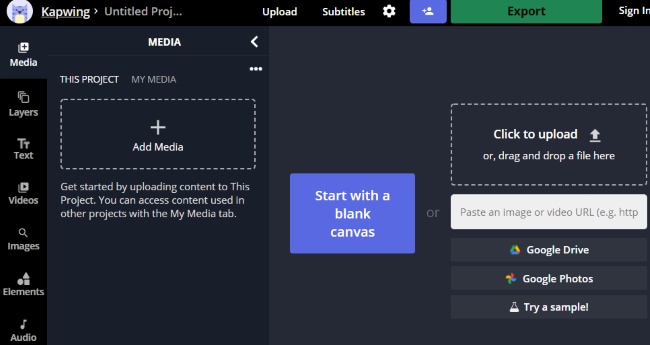
Step 2
You have several options to upload your video from the web or your device. The Upload button allows you to upload videos from your system.
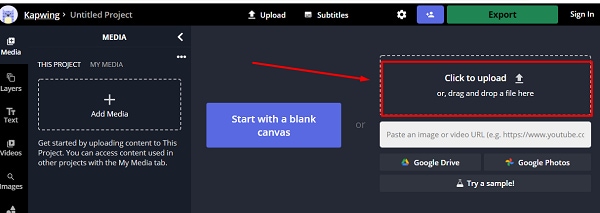
Step 3
You can also drag and drop the file onto the workspace or the Studio canvas. Alternatively, you can copy and paste the URL of your video from sites GIPHY, Google Drive, or YouTube and import it directly.
Once you have uploaded your video, you can start using Kapwing Video Trimmer to trim unnecessary content or make it shorter.
Step 4
A box will pop up at the bottom of the screen; this is referred to as the Timeline, and it’s where the different pieces you’re adding to the video will appear, including images layers, text layers, and video clips.

Step 5
Your video plays from the left side to the right side. The Play icon allows you to play the video and preview your project. Use the seeker to go to any point of your video that you want to see how it will look like.
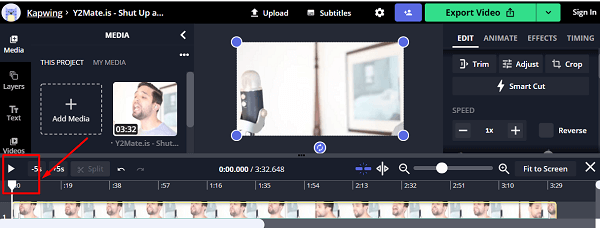
Step 6
If you want more precision while editing individual video clips in the Timeline, use the Zoom In and Zoom out buttons to see a more precise view.
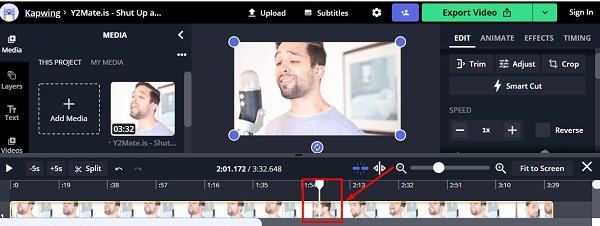
Step 7
To trim the video, click the Trim button.
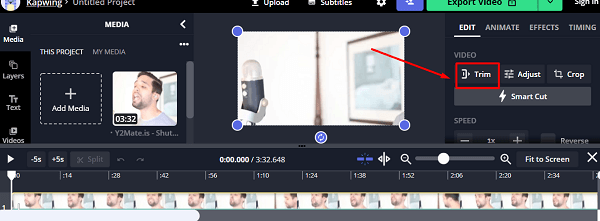
Click and drag the ends of your video to adjust the end and start times of the video layer. Anything that you remove won’t be in the final video.
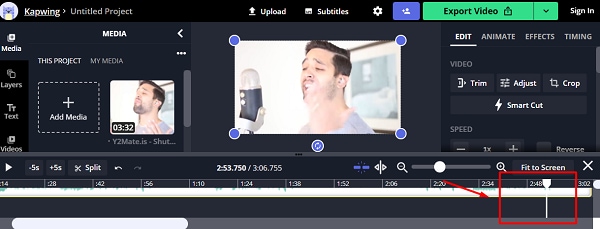
If you have more layers on your project, click and select the layer you would like to trim.
Step 8
You can also use the Timing tab to trim your video. To do this, click your clip and head over to the top right side of your screen.
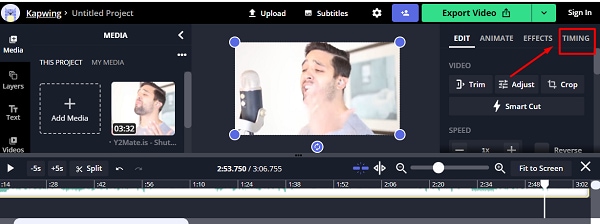
You can now specify the exact time you would like the video to start and end instead of using the clicking and dragging method.
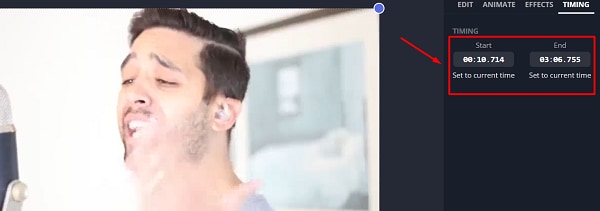
Clicking the numerals will allow you to use the up and down arrow keys and trim the video to start and end where you have specified.
You can also use the seeker to set the time where you would like the video to start and end, and then go to the numerals and click set to the current time.
Kapwing Video Trimmer will create a huge gap when you select this option. You’ll see a blank white canvas until the video starts.
You can leave this white space and add other clips or remove it so that your video starts at zero by clicking it and hitting the Delete key on your keyboard.
Step 9
Once you have finished trimming your video with Video Trimmer Kapwing, click the Export Video button.
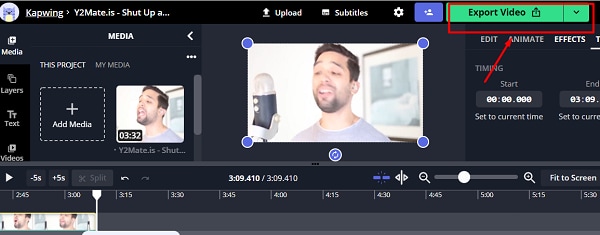
You’ll have to sign in to remove the watermark. Click the Download button to download the trimmed video to your device.
Extra Information About Kapwing Editor
Now that you know how to trim videos with Kapwing Video Trimmer let’s look at five things about this online editing tool that you need to know.
1. You Can Cut and Split Parts of Your Videos
With the Kapwing Video Editing tool, you can cut out the middle of your video clip by using the split key. You only need to drag the seeker to where you would like to cut out, then click the Split button. Doing this will turn the original video clip into two clips that you drag to trim down any part that you do not want to appear in your video.

2. How to Collaborate With Kapwing
Kapwing allows you to work as a group remotely and in real-time while accessing each other’s files. The tool is also ideal for teams, outsourced workers, and virtual assistants. All you have to do is invite your peers or colleagues to a Workspace, and Kaping will allow you to work together on GIF, video, and image edits.
To share your Kapwing Workspace to collaborate with other users without giving them your log-in information, follow the steps below.
- Simply go to the folder you would like to share and hit the Share button.
- You’ll then have to type in the email address of the person you want to share the folder with.
- Once you have done this, click the Send Invite button to copy and send a link to an invitation to your folder.
Your collaborator needs to open the email with the link and click Join Now. They’ll also have to create an account by linking their Facebook or Google account and then accept the invite again once they have signed in.
3. You Can Add Audio and Text to Your Video
Kapwing editor allows you to add audio and text using two methods: subtitles and text boxes. Use single text boxes for information, names, titles, and labels. To do this, hit the Text button located in the upper toolbar, then enter the text you want into the box.
All the text editing options will appear on the right, including angle, position, style, outline, color, and font. The Anime tab allows you to add up to 10 different animations to the text box. Additionally, you can add subtitles to your videos if you want your audience to follow along while listening to the spoken words in the video.
4. Share Your Videos With Others
After creating your video project, you can share it with others from the download page. You can share your video directly on Instagram. Twitter, and Facebook. You can also copy the video’s link and then send it to anyone you want, and they will be able to view it.
Desktop solution for video trimming - Filmora
Filmora is also a video editing tool that allows you to create HD videos. The software lets you crop, trim, merge, and rotate videos. This simple-to-use tool empowers your stories by making your videos eyecatching to attract more viewers. You can also adjust contrast, brightness, temperature, saturation, and tint.
Moreover, you can remove background and apply effects. Filmora has tons of effects on its Effects library that you can just drag and drop onto your video clip after placing it on the timeline.
The 4K editing support feature allows you to edit and export your videos at 4K resolution. You can also adjust the dynamic range and white balance of your videos.
Conclusion
● Kapwing Trimmer allows you to trim videos and remove unwanted scenes and let you start the videos where you want them to begin. The best part is: After you have finished working on your videos, the platform allows you to share them with other websites. Use Filmora to edit your videos and enhance their quality.
When you make a video, you’re competing for people’s attention. Trimming videos is a fundamental element of editing. Strategic video trimming with Kapwing Trimmer allows you to cut out anything unnecessary, leaving you with the content your audience desires. Many people also use this tool to trim the end or beginning of their videos to help them get the attention they deserve. We’ll explain how to trim videos with the Kapwing Trim online tool.
In this article
02 How to Trim a Video with Kapwing
03 Extra Information About Kapwing Editor
What Is Kapwing Editor?
Kapwing is an online GIF, video, and image editing platform designed to enable digital storytelling. This online tool helps you trim videos and add subtitles. It’s user-friendly, and anyone with an idea of video production can use it. You do not need tutorials or software download to start using this tool; you only need efficient creativity, as you can edit a video as much as your creativity will allow you.
The selling point for Kapwing is how easy you can use the online editing tool, making it suitable for both professional and amateur video producers. For this reason, the popularity of Kapwing Video Trimmer has grown 10x, with over 1 million people using this editing tool.
With Kapwing editor, you can filter, trim, resize, and loop videos. The tool also allows you to add audio to your video and sync it with the video. What’s more? You can convert images to videos and watermark them.
Having multiple templates and tools makes things easy, and this will help you make professional-like videos that people will think you used high-end software.
How to Trim a Video with Kapwing
To start using Kapwing Video Trim, you need to follow the steps below:
Step 1
Visit Kapwing.com with your browser using your tablet, smartphone, or computer.Hit the Start Editing button to enter the Studio; no need to create an account.

Step 2
You have several options to upload your video from the web or your device. The Upload button allows you to upload videos from your system.

Step 3
You can also drag and drop the file onto the workspace or the Studio canvas. Alternatively, you can copy and paste the URL of your video from sites GIPHY, Google Drive, or YouTube and import it directly.
Once you have uploaded your video, you can start using Kapwing Video Trimmer to trim unnecessary content or make it shorter.
Step 4
A box will pop up at the bottom of the screen; this is referred to as the Timeline, and it’s where the different pieces you’re adding to the video will appear, including images layers, text layers, and video clips.

Step 5
Your video plays from the left side to the right side. The Play icon allows you to play the video and preview your project. Use the seeker to go to any point of your video that you want to see how it will look like.

Step 6
If you want more precision while editing individual video clips in the Timeline, use the Zoom In and Zoom out buttons to see a more precise view.

Step 7
To trim the video, click the Trim button.

Click and drag the ends of your video to adjust the end and start times of the video layer. Anything that you remove won’t be in the final video.

If you have more layers on your project, click and select the layer you would like to trim.
Step 8
You can also use the Timing tab to trim your video. To do this, click your clip and head over to the top right side of your screen.

You can now specify the exact time you would like the video to start and end instead of using the clicking and dragging method.

Clicking the numerals will allow you to use the up and down arrow keys and trim the video to start and end where you have specified.
You can also use the seeker to set the time where you would like the video to start and end, and then go to the numerals and click set to the current time.
Kapwing Video Trimmer will create a huge gap when you select this option. You’ll see a blank white canvas until the video starts.
You can leave this white space and add other clips or remove it so that your video starts at zero by clicking it and hitting the Delete key on your keyboard.
Step 9
Once you have finished trimming your video with Video Trimmer Kapwing, click the Export Video button.

You’ll have to sign in to remove the watermark. Click the Download button to download the trimmed video to your device.
Extra Information About Kapwing Editor
Now that you know how to trim videos with Kapwing Video Trimmer let’s look at five things about this online editing tool that you need to know.
1. You Can Cut and Split Parts of Your Videos
With the Kapwing Video Editing tool, you can cut out the middle of your video clip by using the split key. You only need to drag the seeker to where you would like to cut out, then click the Split button. Doing this will turn the original video clip into two clips that you drag to trim down any part that you do not want to appear in your video.

2. How to Collaborate With Kapwing
Kapwing allows you to work as a group remotely and in real-time while accessing each other’s files. The tool is also ideal for teams, outsourced workers, and virtual assistants. All you have to do is invite your peers or colleagues to a Workspace, and Kaping will allow you to work together on GIF, video, and image edits.
To share your Kapwing Workspace to collaborate with other users without giving them your log-in information, follow the steps below.
- Simply go to the folder you would like to share and hit the Share button.
- You’ll then have to type in the email address of the person you want to share the folder with.
- Once you have done this, click the Send Invite button to copy and send a link to an invitation to your folder.
Your collaborator needs to open the email with the link and click Join Now. They’ll also have to create an account by linking their Facebook or Google account and then accept the invite again once they have signed in.
3. You Can Add Audio and Text to Your Video
Kapwing editor allows you to add audio and text using two methods: subtitles and text boxes. Use single text boxes for information, names, titles, and labels. To do this, hit the Text button located in the upper toolbar, then enter the text you want into the box.
All the text editing options will appear on the right, including angle, position, style, outline, color, and font. The Anime tab allows you to add up to 10 different animations to the text box. Additionally, you can add subtitles to your videos if you want your audience to follow along while listening to the spoken words in the video.
4. Share Your Videos With Others
After creating your video project, you can share it with others from the download page. You can share your video directly on Instagram. Twitter, and Facebook. You can also copy the video’s link and then send it to anyone you want, and they will be able to view it.
Desktop solution for video trimming - Filmora
Filmora is also a video editing tool that allows you to create HD videos. The software lets you crop, trim, merge, and rotate videos. This simple-to-use tool empowers your stories by making your videos eyecatching to attract more viewers. You can also adjust contrast, brightness, temperature, saturation, and tint.
Moreover, you can remove background and apply effects. Filmora has tons of effects on its Effects library that you can just drag and drop onto your video clip after placing it on the timeline.
The 4K editing support feature allows you to edit and export your videos at 4K resolution. You can also adjust the dynamic range and white balance of your videos.
Conclusion
● Kapwing Trimmer allows you to trim videos and remove unwanted scenes and let you start the videos where you want them to begin. The best part is: After you have finished working on your videos, the platform allows you to share them with other websites. Use Filmora to edit your videos and enhance their quality.
When you make a video, you’re competing for people’s attention. Trimming videos is a fundamental element of editing. Strategic video trimming with Kapwing Trimmer allows you to cut out anything unnecessary, leaving you with the content your audience desires. Many people also use this tool to trim the end or beginning of their videos to help them get the attention they deserve. We’ll explain how to trim videos with the Kapwing Trim online tool.
In this article
02 How to Trim a Video with Kapwing
03 Extra Information About Kapwing Editor
What Is Kapwing Editor?
Kapwing is an online GIF, video, and image editing platform designed to enable digital storytelling. This online tool helps you trim videos and add subtitles. It’s user-friendly, and anyone with an idea of video production can use it. You do not need tutorials or software download to start using this tool; you only need efficient creativity, as you can edit a video as much as your creativity will allow you.
The selling point for Kapwing is how easy you can use the online editing tool, making it suitable for both professional and amateur video producers. For this reason, the popularity of Kapwing Video Trimmer has grown 10x, with over 1 million people using this editing tool.
With Kapwing editor, you can filter, trim, resize, and loop videos. The tool also allows you to add audio to your video and sync it with the video. What’s more? You can convert images to videos and watermark them.
Having multiple templates and tools makes things easy, and this will help you make professional-like videos that people will think you used high-end software.
How to Trim a Video with Kapwing
To start using Kapwing Video Trim, you need to follow the steps below:
Step 1
Visit Kapwing.com with your browser using your tablet, smartphone, or computer.Hit the Start Editing button to enter the Studio; no need to create an account.

Step 2
You have several options to upload your video from the web or your device. The Upload button allows you to upload videos from your system.

Step 3
You can also drag and drop the file onto the workspace or the Studio canvas. Alternatively, you can copy and paste the URL of your video from sites GIPHY, Google Drive, or YouTube and import it directly.
Once you have uploaded your video, you can start using Kapwing Video Trimmer to trim unnecessary content or make it shorter.
Step 4
A box will pop up at the bottom of the screen; this is referred to as the Timeline, and it’s where the different pieces you’re adding to the video will appear, including images layers, text layers, and video clips.

Step 5
Your video plays from the left side to the right side. The Play icon allows you to play the video and preview your project. Use the seeker to go to any point of your video that you want to see how it will look like.

Step 6
If you want more precision while editing individual video clips in the Timeline, use the Zoom In and Zoom out buttons to see a more precise view.

Step 7
To trim the video, click the Trim button.

Click and drag the ends of your video to adjust the end and start times of the video layer. Anything that you remove won’t be in the final video.

If you have more layers on your project, click and select the layer you would like to trim.
Step 8
You can also use the Timing tab to trim your video. To do this, click your clip and head over to the top right side of your screen.

You can now specify the exact time you would like the video to start and end instead of using the clicking and dragging method.

Clicking the numerals will allow you to use the up and down arrow keys and trim the video to start and end where you have specified.
You can also use the seeker to set the time where you would like the video to start and end, and then go to the numerals and click set to the current time.
Kapwing Video Trimmer will create a huge gap when you select this option. You’ll see a blank white canvas until the video starts.
You can leave this white space and add other clips or remove it so that your video starts at zero by clicking it and hitting the Delete key on your keyboard.
Step 9
Once you have finished trimming your video with Video Trimmer Kapwing, click the Export Video button.

You’ll have to sign in to remove the watermark. Click the Download button to download the trimmed video to your device.
Extra Information About Kapwing Editor
Now that you know how to trim videos with Kapwing Video Trimmer let’s look at five things about this online editing tool that you need to know.
1. You Can Cut and Split Parts of Your Videos
With the Kapwing Video Editing tool, you can cut out the middle of your video clip by using the split key. You only need to drag the seeker to where you would like to cut out, then click the Split button. Doing this will turn the original video clip into two clips that you drag to trim down any part that you do not want to appear in your video.

2. How to Collaborate With Kapwing
Kapwing allows you to work as a group remotely and in real-time while accessing each other’s files. The tool is also ideal for teams, outsourced workers, and virtual assistants. All you have to do is invite your peers or colleagues to a Workspace, and Kaping will allow you to work together on GIF, video, and image edits.
To share your Kapwing Workspace to collaborate with other users without giving them your log-in information, follow the steps below.
- Simply go to the folder you would like to share and hit the Share button.
- You’ll then have to type in the email address of the person you want to share the folder with.
- Once you have done this, click the Send Invite button to copy and send a link to an invitation to your folder.
Your collaborator needs to open the email with the link and click Join Now. They’ll also have to create an account by linking their Facebook or Google account and then accept the invite again once they have signed in.
3. You Can Add Audio and Text to Your Video
Kapwing editor allows you to add audio and text using two methods: subtitles and text boxes. Use single text boxes for information, names, titles, and labels. To do this, hit the Text button located in the upper toolbar, then enter the text you want into the box.
All the text editing options will appear on the right, including angle, position, style, outline, color, and font. The Anime tab allows you to add up to 10 different animations to the text box. Additionally, you can add subtitles to your videos if you want your audience to follow along while listening to the spoken words in the video.
4. Share Your Videos With Others
After creating your video project, you can share it with others from the download page. You can share your video directly on Instagram. Twitter, and Facebook. You can also copy the video’s link and then send it to anyone you want, and they will be able to view it.
Desktop solution for video trimming - Filmora
Filmora is also a video editing tool that allows you to create HD videos. The software lets you crop, trim, merge, and rotate videos. This simple-to-use tool empowers your stories by making your videos eyecatching to attract more viewers. You can also adjust contrast, brightness, temperature, saturation, and tint.
Moreover, you can remove background and apply effects. Filmora has tons of effects on its Effects library that you can just drag and drop onto your video clip after placing it on the timeline.
The 4K editing support feature allows you to edit and export your videos at 4K resolution. You can also adjust the dynamic range and white balance of your videos.
Conclusion
● Kapwing Trimmer allows you to trim videos and remove unwanted scenes and let you start the videos where you want them to begin. The best part is: After you have finished working on your videos, the platform allows you to share them with other websites. Use Filmora to edit your videos and enhance their quality.
When you make a video, you’re competing for people’s attention. Trimming videos is a fundamental element of editing. Strategic video trimming with Kapwing Trimmer allows you to cut out anything unnecessary, leaving you with the content your audience desires. Many people also use this tool to trim the end or beginning of their videos to help them get the attention they deserve. We’ll explain how to trim videos with the Kapwing Trim online tool.
In this article
02 How to Trim a Video with Kapwing
03 Extra Information About Kapwing Editor
What Is Kapwing Editor?
Kapwing is an online GIF, video, and image editing platform designed to enable digital storytelling. This online tool helps you trim videos and add subtitles. It’s user-friendly, and anyone with an idea of video production can use it. You do not need tutorials or software download to start using this tool; you only need efficient creativity, as you can edit a video as much as your creativity will allow you.
The selling point for Kapwing is how easy you can use the online editing tool, making it suitable for both professional and amateur video producers. For this reason, the popularity of Kapwing Video Trimmer has grown 10x, with over 1 million people using this editing tool.
With Kapwing editor, you can filter, trim, resize, and loop videos. The tool also allows you to add audio to your video and sync it with the video. What’s more? You can convert images to videos and watermark them.
Having multiple templates and tools makes things easy, and this will help you make professional-like videos that people will think you used high-end software.
How to Trim a Video with Kapwing
To start using Kapwing Video Trim, you need to follow the steps below:
Step 1
Visit Kapwing.com with your browser using your tablet, smartphone, or computer.Hit the Start Editing button to enter the Studio; no need to create an account.

Step 2
You have several options to upload your video from the web or your device. The Upload button allows you to upload videos from your system.

Step 3
You can also drag and drop the file onto the workspace or the Studio canvas. Alternatively, you can copy and paste the URL of your video from sites GIPHY, Google Drive, or YouTube and import it directly.
Once you have uploaded your video, you can start using Kapwing Video Trimmer to trim unnecessary content or make it shorter.
Step 4
A box will pop up at the bottom of the screen; this is referred to as the Timeline, and it’s where the different pieces you’re adding to the video will appear, including images layers, text layers, and video clips.

Step 5
Your video plays from the left side to the right side. The Play icon allows you to play the video and preview your project. Use the seeker to go to any point of your video that you want to see how it will look like.

Step 6
If you want more precision while editing individual video clips in the Timeline, use the Zoom In and Zoom out buttons to see a more precise view.

Step 7
To trim the video, click the Trim button.

Click and drag the ends of your video to adjust the end and start times of the video layer. Anything that you remove won’t be in the final video.

If you have more layers on your project, click and select the layer you would like to trim.
Step 8
You can also use the Timing tab to trim your video. To do this, click your clip and head over to the top right side of your screen.

You can now specify the exact time you would like the video to start and end instead of using the clicking and dragging method.

Clicking the numerals will allow you to use the up and down arrow keys and trim the video to start and end where you have specified.
You can also use the seeker to set the time where you would like the video to start and end, and then go to the numerals and click set to the current time.
Kapwing Video Trimmer will create a huge gap when you select this option. You’ll see a blank white canvas until the video starts.
You can leave this white space and add other clips or remove it so that your video starts at zero by clicking it and hitting the Delete key on your keyboard.
Step 9
Once you have finished trimming your video with Video Trimmer Kapwing, click the Export Video button.

You’ll have to sign in to remove the watermark. Click the Download button to download the trimmed video to your device.
Extra Information About Kapwing Editor
Now that you know how to trim videos with Kapwing Video Trimmer let’s look at five things about this online editing tool that you need to know.
1. You Can Cut and Split Parts of Your Videos
With the Kapwing Video Editing tool, you can cut out the middle of your video clip by using the split key. You only need to drag the seeker to where you would like to cut out, then click the Split button. Doing this will turn the original video clip into two clips that you drag to trim down any part that you do not want to appear in your video.

2. How to Collaborate With Kapwing
Kapwing allows you to work as a group remotely and in real-time while accessing each other’s files. The tool is also ideal for teams, outsourced workers, and virtual assistants. All you have to do is invite your peers or colleagues to a Workspace, and Kaping will allow you to work together on GIF, video, and image edits.
To share your Kapwing Workspace to collaborate with other users without giving them your log-in information, follow the steps below.
- Simply go to the folder you would like to share and hit the Share button.
- You’ll then have to type in the email address of the person you want to share the folder with.
- Once you have done this, click the Send Invite button to copy and send a link to an invitation to your folder.
Your collaborator needs to open the email with the link and click Join Now. They’ll also have to create an account by linking their Facebook or Google account and then accept the invite again once they have signed in.
3. You Can Add Audio and Text to Your Video
Kapwing editor allows you to add audio and text using two methods: subtitles and text boxes. Use single text boxes for information, names, titles, and labels. To do this, hit the Text button located in the upper toolbar, then enter the text you want into the box.
All the text editing options will appear on the right, including angle, position, style, outline, color, and font. The Anime tab allows you to add up to 10 different animations to the text box. Additionally, you can add subtitles to your videos if you want your audience to follow along while listening to the spoken words in the video.
4. Share Your Videos With Others
After creating your video project, you can share it with others from the download page. You can share your video directly on Instagram. Twitter, and Facebook. You can also copy the video’s link and then send it to anyone you want, and they will be able to view it.
Desktop solution for video trimming - Filmora
Filmora is also a video editing tool that allows you to create HD videos. The software lets you crop, trim, merge, and rotate videos. This simple-to-use tool empowers your stories by making your videos eyecatching to attract more viewers. You can also adjust contrast, brightness, temperature, saturation, and tint.
Moreover, you can remove background and apply effects. Filmora has tons of effects on its Effects library that you can just drag and drop onto your video clip after placing it on the timeline.
The 4K editing support feature allows you to edit and export your videos at 4K resolution. You can also adjust the dynamic range and white balance of your videos.
Conclusion
● Kapwing Trimmer allows you to trim videos and remove unwanted scenes and let you start the videos where you want them to begin. The best part is: After you have finished working on your videos, the platform allows you to share them with other websites. Use Filmora to edit your videos and enhance their quality.
Cloud Stop Motion Software Guidelines and Alternatives
Creating a stop motion video is a fascinating process. If you use the right software and know the basics of making videos, you can create fantastic animations. While creating a stop motion video, there are things to keep in mind, like keeping the cameras steady and using the proper audio effects. Cloud Stop motion is well-known software with the tools to create unique video projects on your smartphone, laptop, desktop, Chromebook, or even tablet.
Part 1. Introduction- Cloud Stop Motion
It is easy to create stop motion animation with this web-based app. To use cloud stop motion you must first create an account and grant the app permission to your computer’s webcam. Then you can start a new project and start taking pictures.
Each image is displayed on the timeline to know all photos that are going to be included in the stop motion video. On Cloud Stop Motion, you have the option to either record or import audio files from the sound library or your device. You can add additional things, like opening titles, end credits, speech bubbles, and text overlays. It functions directly in the browser on any modern device.
You do not have to install anything. It is all saved to the cloud. You can work with your animation on a zoomable, scrollable timeline.
Features -
- Easy to use, powerful, and intuitive software to create animations.
- The Interface has a modern design.
- It is equipped with a rich audio library, backgrounds and styles included.
- You can switch devices seamlessly at any point.
Part 2. How to Use Cloud Stop Motion to Create Animation Videos?
Cloud Stop Motion is a great browser-based app that one can use to create fun animation videos. You can use Cloud Stop Motion even when you have not created your account. But consider creating an account to enjoy additional features.

Before you open Cloud Stop Motion and start clicking pictures of your subject for your video, it is important to have a story in mind. So, create a storyboard to break down your stop motion video. You can sketch your plan frame by frame or write bulleted list of your frames. It will help you create your project efficiently, ensuring that you have taken pictures of all the frames that you need to tell your story.

Step 1: Once you have created your storyboard, open the app to go to the Cloud Stop Motion dashboard. Click on the new project button. Cloud Stop Motion needs access to your camera for capturing images. So, allow camera access.

On the dashboard, go to the taking picture menu. Now place the subject at the center of your frame. Capture a few test shots to find the composition that you like. You can see the picture at the bottom of the timeline. If needed, adjust the position of your subject. Make sure that the location you choose has plenty of light. If not, you also use a lamp for good light.
Tip: Keeping your phone or camera steady while making your stop-motion project is the key. You can use a tripod, a selfie stick, or a gimbal to keep your device as still as possible. If you don’t own any of these, keep your device on something sturdy and make sure that you do not change its place until you capture all the images needed for your project. This way all your shots will be consistent.
Step 2: Move your subject or change its position and take a picture. Repeat the process until you complete your story. To make your stop-motion smooth, make small changes to the position of your subject between shots.
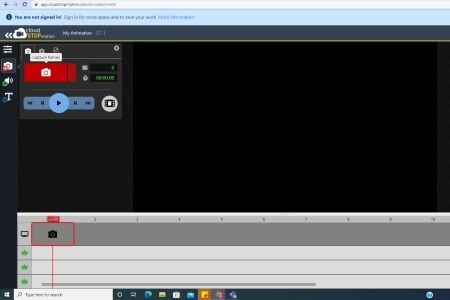
You can also add more frames per second. Generally, you should add 10 frames per second. But you can go for 25 frames per second to make a smoother video. All the pictures you snap are automatically added to the editor in chronological order.
Step 3: Once you have captured images for your project, add sound by going to the sound menu in the top left of the dashboard. You can record sounds, upload sounds, or select sounds from Cloud Stop Motion’s gallery. You can also add text to your Cloud Stop Motion project if you want.
Step 4: Click on play button to preview your project and see if your motion picture turned out as per your liking or not. If you do not like something, go back and make changes. Once done, download your video from cloudstop motion.
Part 3. 3 Alternatives for Cloud Stop Motion
Are you ready to turn your video clips and images into a stop motion movie? Have a look at all these software that can create animations wonderfully well. You can share the animations with your friends on social media platforms. The stop motion effect is ideal for action videos.
1. Stop Motion Animator
It is a simple tool for creating stop motion animation sequences using a webcam. You can save the animation as a video file in the widely-supported webm format. The videos previously saved can be loaded into the app and extended. Stop Motion Animator is free software that lets you create fantastic stop motion videos. It is an open-source, non-commercial app.
It does not collect any data, and it does not connect to the internet at all.
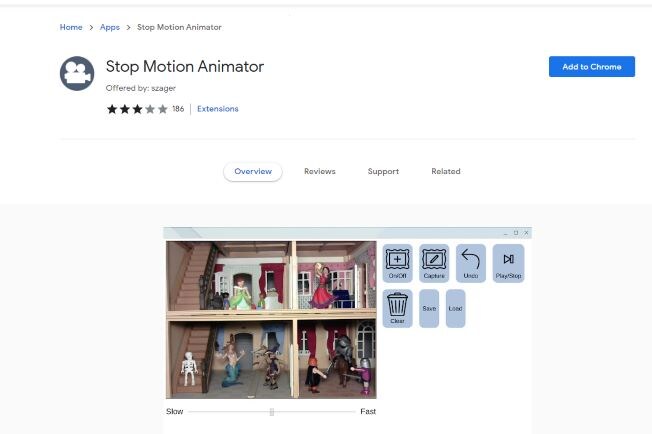
2. Kapwig
Whether you’re a beginner video creator or advanced, Kapwing is the right tool to create stop motion animation. It is an all-in-one online video studio as it has an intuitive timeline, advanced editor, and plugin ecosystem that will help you make next-level videos.
Kapwing Studio supports many different file types like MP4, MOV, AVI, 3GP. Record video clips, add voiceovers and add images and texts to create a fresh stop motion video. Then you can edit them in the browser from any device. If you like how the final video looks, click “Export.” Download the MP4 file directly, publish the video on social media, or share the link with your friends.
You can customize the output video size in 1:1, 9:16, 16:9, 4:5, or 5:4. Sign in to the Kapwing account to remove the watermark.
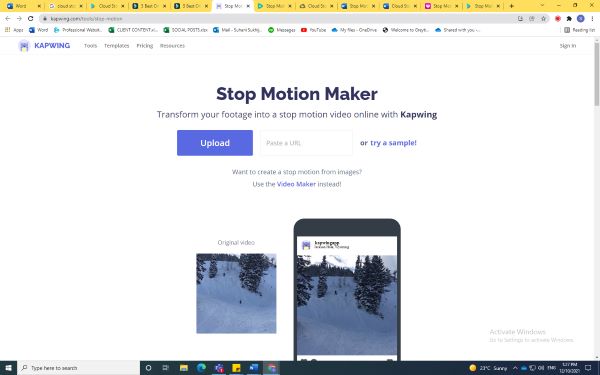
3. Clideo
Clideo is a high-speed stop motion maker with an easy-to-use dashboard and instant download. It is compatible with almost all the video formats such as AVI, MPG, VOB, WMV, MOV, and more. When creating a stop motion, you can choose from various frame and clip rates available. They slow down, speed up or maintain the same speed for your video. The interface is intuitive, so you don’t have to have experience using the stop motion editor.
Just upload a video file from your device- whether it’s a computer, iPhone, or android phone. Apply the effects that go with your movie. You can watch the final result and click the “Download” button.
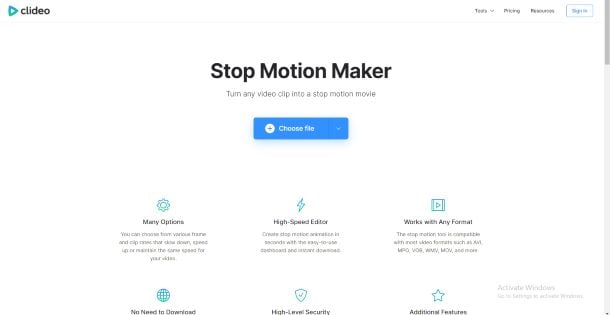
Closing Word
Recording and editing stop motion animation has never been easier. You can thousands of images and create video projects quickly on Cloud stop motion.
Each software we include in this article grants you access to all the necessary tools you’ll need while creating a stop motion animation. Are you impressed with cloud stop motion or one of the alternatives? Leave a comment and let us know.
Part 2. How to Use Cloud Stop Motion to Create Animation Videos?
Cloud Stop Motion is a great browser-based app that one can use to create fun animation videos. You can use Cloud Stop Motion even when you have not created your account. But consider creating an account to enjoy additional features.

Before you open Cloud Stop Motion and start clicking pictures of your subject for your video, it is important to have a story in mind. So, create a storyboard to break down your stop motion video. You can sketch your plan frame by frame or write bulleted list of your frames. It will help you create your project efficiently, ensuring that you have taken pictures of all the frames that you need to tell your story.

Step 1: Once you have created your storyboard, open the app to go to the Cloud Stop Motion dashboard. Click on the new project button. Cloud Stop Motion needs access to your camera for capturing images. So, allow camera access.

On the dashboard, go to the taking picture menu. Now place the subject at the center of your frame. Capture a few test shots to find the composition that you like. You can see the picture at the bottom of the timeline. If needed, adjust the position of your subject. Make sure that the location you choose has plenty of light. If not, you also use a lamp for good light.
Tip: Keeping your phone or camera steady while making your stop-motion project is the key. You can use a tripod, a selfie stick, or a gimbal to keep your device as still as possible. If you don’t own any of these, keep your device on something sturdy and make sure that you do not change its place until you capture all the images needed for your project. This way all your shots will be consistent.
Step 2: Move your subject or change its position and take a picture. Repeat the process until you complete your story. To make your stop-motion smooth, make small changes to the position of your subject between shots.

You can also add more frames per second. Generally, you should add 10 frames per second. But you can go for 25 frames per second to make a smoother video. All the pictures you snap are automatically added to the editor in chronological order.
Step 3: Once you have captured images for your project, add sound by going to the sound menu in the top left of the dashboard. You can record sounds, upload sounds, or select sounds from Cloud Stop Motion’s gallery. You can also add text to your Cloud Stop Motion project if you want.
Step 4: Click on play button to preview your project and see if your motion picture turned out as per your liking or not. If you do not like something, go back and make changes. Once done, download your video from cloudstop motion.
Part 3. 3 Alternatives for Cloud Stop Motion
Are you ready to turn your video clips and images into a stop motion movie? Have a look at all these software that can create animations wonderfully well. You can share the animations with your friends on social media platforms. The stop motion effect is ideal for action videos.
1. Stop Motion Animator
It is a simple tool for creating stop motion animation sequences using a webcam. You can save the animation as a video file in the widely-supported webm format. The videos previously saved can be loaded into the app and extended. Stop Motion Animator is free software that lets you create fantastic stop motion videos. It is an open-source, non-commercial app.
It does not collect any data, and it does not connect to the internet at all.

2. Kapwig
Whether you’re a beginner video creator or advanced, Kapwing is the right tool to create stop motion animation. It is an all-in-one online video studio as it has an intuitive timeline, advanced editor, and plugin ecosystem that will help you make next-level videos.
Kapwing Studio supports many different file types like MP4, MOV, AVI, 3GP. Record video clips, add voiceovers and add images and texts to create a fresh stop motion video. Then you can edit them in the browser from any device. If you like how the final video looks, click “Export.” Download the MP4 file directly, publish the video on social media, or share the link with your friends.
You can customize the output video size in 1:1, 9:16, 16:9, 4:5, or 5:4. Sign in to the Kapwing account to remove the watermark.

3. Clideo
Clideo is a high-speed stop motion maker with an easy-to-use dashboard and instant download. It is compatible with almost all the video formats such as AVI, MPG, VOB, WMV, MOV, and more. When creating a stop motion, you can choose from various frame and clip rates available. They slow down, speed up or maintain the same speed for your video. The interface is intuitive, so you don’t have to have experience using the stop motion editor.
Just upload a video file from your device- whether it’s a computer, iPhone, or android phone. Apply the effects that go with your movie. You can watch the final result and click the “Download” button.

Closing Word
Recording and editing stop motion animation has never been easier. You can thousands of images and create video projects quickly on Cloud stop motion.
Each software we include in this article grants you access to all the necessary tools you’ll need while creating a stop motion animation. Are you impressed with cloud stop motion or one of the alternatives? Leave a comment and let us know.
Part 2. How to Use Cloud Stop Motion to Create Animation Videos?
Cloud Stop Motion is a great browser-based app that one can use to create fun animation videos. You can use Cloud Stop Motion even when you have not created your account. But consider creating an account to enjoy additional features.

Before you open Cloud Stop Motion and start clicking pictures of your subject for your video, it is important to have a story in mind. So, create a storyboard to break down your stop motion video. You can sketch your plan frame by frame or write bulleted list of your frames. It will help you create your project efficiently, ensuring that you have taken pictures of all the frames that you need to tell your story.

Step 1: Once you have created your storyboard, open the app to go to the Cloud Stop Motion dashboard. Click on the new project button. Cloud Stop Motion needs access to your camera for capturing images. So, allow camera access.

On the dashboard, go to the taking picture menu. Now place the subject at the center of your frame. Capture a few test shots to find the composition that you like. You can see the picture at the bottom of the timeline. If needed, adjust the position of your subject. Make sure that the location you choose has plenty of light. If not, you also use a lamp for good light.
Tip: Keeping your phone or camera steady while making your stop-motion project is the key. You can use a tripod, a selfie stick, or a gimbal to keep your device as still as possible. If you don’t own any of these, keep your device on something sturdy and make sure that you do not change its place until you capture all the images needed for your project. This way all your shots will be consistent.
Step 2: Move your subject or change its position and take a picture. Repeat the process until you complete your story. To make your stop-motion smooth, make small changes to the position of your subject between shots.

You can also add more frames per second. Generally, you should add 10 frames per second. But you can go for 25 frames per second to make a smoother video. All the pictures you snap are automatically added to the editor in chronological order.
Step 3: Once you have captured images for your project, add sound by going to the sound menu in the top left of the dashboard. You can record sounds, upload sounds, or select sounds from Cloud Stop Motion’s gallery. You can also add text to your Cloud Stop Motion project if you want.
Step 4: Click on play button to preview your project and see if your motion picture turned out as per your liking or not. If you do not like something, go back and make changes. Once done, download your video from cloudstop motion.
Part 3. 3 Alternatives for Cloud Stop Motion
Are you ready to turn your video clips and images into a stop motion movie? Have a look at all these software that can create animations wonderfully well. You can share the animations with your friends on social media platforms. The stop motion effect is ideal for action videos.
1. Stop Motion Animator
It is a simple tool for creating stop motion animation sequences using a webcam. You can save the animation as a video file in the widely-supported webm format. The videos previously saved can be loaded into the app and extended. Stop Motion Animator is free software that lets you create fantastic stop motion videos. It is an open-source, non-commercial app.
It does not collect any data, and it does not connect to the internet at all.

2. Kapwig
Whether you’re a beginner video creator or advanced, Kapwing is the right tool to create stop motion animation. It is an all-in-one online video studio as it has an intuitive timeline, advanced editor, and plugin ecosystem that will help you make next-level videos.
Kapwing Studio supports many different file types like MP4, MOV, AVI, 3GP. Record video clips, add voiceovers and add images and texts to create a fresh stop motion video. Then you can edit them in the browser from any device. If you like how the final video looks, click “Export.” Download the MP4 file directly, publish the video on social media, or share the link with your friends.
You can customize the output video size in 1:1, 9:16, 16:9, 4:5, or 5:4. Sign in to the Kapwing account to remove the watermark.

3. Clideo
Clideo is a high-speed stop motion maker with an easy-to-use dashboard and instant download. It is compatible with almost all the video formats such as AVI, MPG, VOB, WMV, MOV, and more. When creating a stop motion, you can choose from various frame and clip rates available. They slow down, speed up or maintain the same speed for your video. The interface is intuitive, so you don’t have to have experience using the stop motion editor.
Just upload a video file from your device- whether it’s a computer, iPhone, or android phone. Apply the effects that go with your movie. You can watch the final result and click the “Download” button.

Closing Word
Recording and editing stop motion animation has never been easier. You can thousands of images and create video projects quickly on Cloud stop motion.
Each software we include in this article grants you access to all the necessary tools you’ll need while creating a stop motion animation. Are you impressed with cloud stop motion or one of the alternatives? Leave a comment and let us know.
Part 2. How to Use Cloud Stop Motion to Create Animation Videos?
Cloud Stop Motion is a great browser-based app that one can use to create fun animation videos. You can use Cloud Stop Motion even when you have not created your account. But consider creating an account to enjoy additional features.

Before you open Cloud Stop Motion and start clicking pictures of your subject for your video, it is important to have a story in mind. So, create a storyboard to break down your stop motion video. You can sketch your plan frame by frame or write bulleted list of your frames. It will help you create your project efficiently, ensuring that you have taken pictures of all the frames that you need to tell your story.

Step 1: Once you have created your storyboard, open the app to go to the Cloud Stop Motion dashboard. Click on the new project button. Cloud Stop Motion needs access to your camera for capturing images. So, allow camera access.

On the dashboard, go to the taking picture menu. Now place the subject at the center of your frame. Capture a few test shots to find the composition that you like. You can see the picture at the bottom of the timeline. If needed, adjust the position of your subject. Make sure that the location you choose has plenty of light. If not, you also use a lamp for good light.
Tip: Keeping your phone or camera steady while making your stop-motion project is the key. You can use a tripod, a selfie stick, or a gimbal to keep your device as still as possible. If you don’t own any of these, keep your device on something sturdy and make sure that you do not change its place until you capture all the images needed for your project. This way all your shots will be consistent.
Step 2: Move your subject or change its position and take a picture. Repeat the process until you complete your story. To make your stop-motion smooth, make small changes to the position of your subject between shots.

You can also add more frames per second. Generally, you should add 10 frames per second. But you can go for 25 frames per second to make a smoother video. All the pictures you snap are automatically added to the editor in chronological order.
Step 3: Once you have captured images for your project, add sound by going to the sound menu in the top left of the dashboard. You can record sounds, upload sounds, or select sounds from Cloud Stop Motion’s gallery. You can also add text to your Cloud Stop Motion project if you want.
Step 4: Click on play button to preview your project and see if your motion picture turned out as per your liking or not. If you do not like something, go back and make changes. Once done, download your video from cloudstop motion.
Part 3. 3 Alternatives for Cloud Stop Motion
Are you ready to turn your video clips and images into a stop motion movie? Have a look at all these software that can create animations wonderfully well. You can share the animations with your friends on social media platforms. The stop motion effect is ideal for action videos.
1. Stop Motion Animator
It is a simple tool for creating stop motion animation sequences using a webcam. You can save the animation as a video file in the widely-supported webm format. The videos previously saved can be loaded into the app and extended. Stop Motion Animator is free software that lets you create fantastic stop motion videos. It is an open-source, non-commercial app.
It does not collect any data, and it does not connect to the internet at all.

2. Kapwig
Whether you’re a beginner video creator or advanced, Kapwing is the right tool to create stop motion animation. It is an all-in-one online video studio as it has an intuitive timeline, advanced editor, and plugin ecosystem that will help you make next-level videos.
Kapwing Studio supports many different file types like MP4, MOV, AVI, 3GP. Record video clips, add voiceovers and add images and texts to create a fresh stop motion video. Then you can edit them in the browser from any device. If you like how the final video looks, click “Export.” Download the MP4 file directly, publish the video on social media, or share the link with your friends.
You can customize the output video size in 1:1, 9:16, 16:9, 4:5, or 5:4. Sign in to the Kapwing account to remove the watermark.

3. Clideo
Clideo is a high-speed stop motion maker with an easy-to-use dashboard and instant download. It is compatible with almost all the video formats such as AVI, MPG, VOB, WMV, MOV, and more. When creating a stop motion, you can choose from various frame and clip rates available. They slow down, speed up or maintain the same speed for your video. The interface is intuitive, so you don’t have to have experience using the stop motion editor.
Just upload a video file from your device- whether it’s a computer, iPhone, or android phone. Apply the effects that go with your movie. You can watch the final result and click the “Download” button.

Closing Word
Recording and editing stop motion animation has never been easier. You can thousands of images and create video projects quickly on Cloud stop motion.
Each software we include in this article grants you access to all the necessary tools you’ll need while creating a stop motion animation. Are you impressed with cloud stop motion or one of the alternatives? Leave a comment and let us know.
Unleash the Drama: Top Slow Motion Video Editing Apps
Top 10+ Slow Motion Video Editing Software

Ollie Mattison
Mar 27, 2024• Proven solutions
Slow motion effects can add a “close-up in time”, and introduce a feeling of surreality. If you want to slow down a video to show more details or transfer a kind of atmosphere to a video, you will need video editing software to do it. Here is a list of some of the best video editors to make a video slow down in the market.
Top 10+ Slow Motion Video Editing Software
1. Wondershare Filmora
Pricing: Free trial
Not just for slowing down or speeding up videos, the Filmora can also be used for a wide array of functions, such like slippting, cropping or reversing videos, and other advanced features like green screen, PIP, and face-off. The recent revamping of the user interface supports the easier use of more tools.
Filmora offers two ways to make a slow-motion effect in a video. The quickest way of applying the slow-motion effect to video is by selecting the target clip in the timeline, clicking the Speed icon in the toolbar, and choosing the target slow speed presets from 0.5X, 0.25X, 0.1X, 0.05X and 0.01X. The smaller the preset is, the slower the video will be.
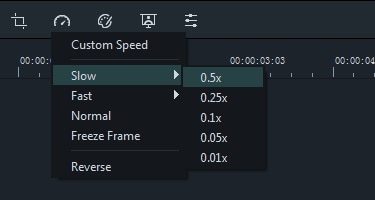
Of course, you can also right-click the video in the timeline, select the Speed and Duration option from the menu and then change the speed by dragging the speed slider or the duration period in the Custom Speed window.

Check the video below to see how to control the video speed and make a fast forward, slow motion or freeze frame video.
For detailed information about how to make a slow-motion video, you can check Tutorial: how to make a slow/fast motion video.
If you’re looking for something more than simple speed change, read this: Ways to Make Smooth Slow-motion and Fast-motion effect.
3. Twixtor
Pricing: Ranges from $82.49 for the upgrades to $595.00 for the full version
Continuously raising the bar for slow motion editing software, Twixtor is probably the most popular and highly praised video editing application that focuses on slow and fast motions in the market. Despite the commendations the software keeps getting, its pricing may be a little too expensive. The full version of Twixtor Pro falls at $595.00.

4. Slomovideo
Pricing: Free
Although its bare and unappealing graphical user interface might turn off some people, Slomovideo does what it was created to do, which is to slow motion in videos down, quite well. To add to that, Slomovideo is an open source program, which means that it is free. A downside, however, is that it seems slower than other software and applications. However, if you are opposed to shelling out hundreds of dollars in order to produce a crisp and smooth slow motion video with expensive software, then this freeware is for you.
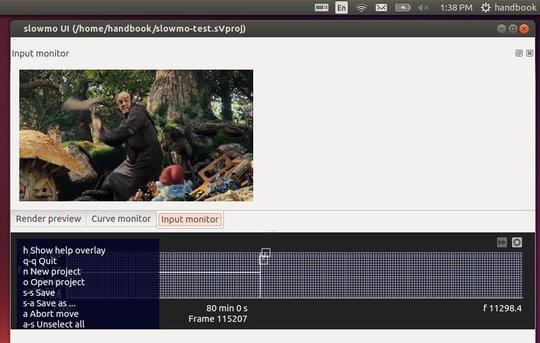
5. MotionPerfect
Pricing: $49.95
This cross-platform utility allows the speed and frame rate to be set and the duration of the files to be changed. Motion compensated interpolation and morphing algorithms are used instead of repeating or blending contiguous frames.
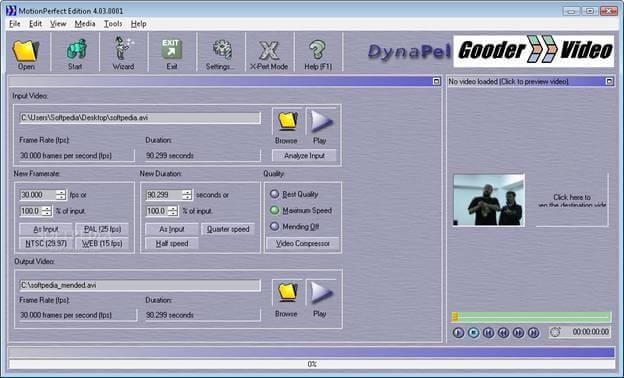
6. Apple Motion
Pricing: Bundled with Apple Final Cut Studio
The feature Optical Flow within Apple Motion was once obscure but now many users attest to its quality. Being bundled with the Apple Final Cut Studio already, previous FCS users can use Apple Motion for free.
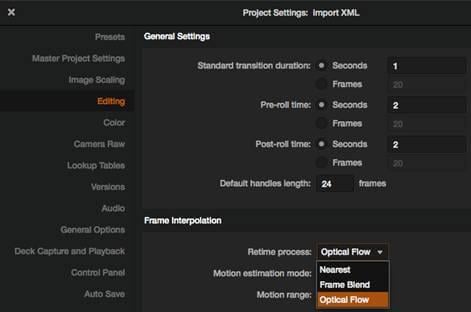
7. Boris Continuum Time Unit
Pricing: $199.00
Using the retiming effects of Optical Flow along with the automatic keyframe generation of the Beat Reactor, Boris Continuum Time Unit can produce high-quality slow and fast motion videos.
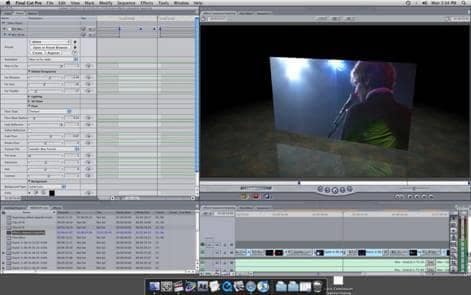
8. ReSpeedr
Pricing: $99
Similar to Slomovideo, Respeedr is also an open source video editing tool. It is a stand-alone application that makes use of a frame-based motion-flow analysis, which means that it uses dynamic frame-blending.It offers an array of time lapse and slow motion tools that are needed to make the transition smooth but the quality of the video crisp. Moreover, its graphical user interface is very easy to understand.
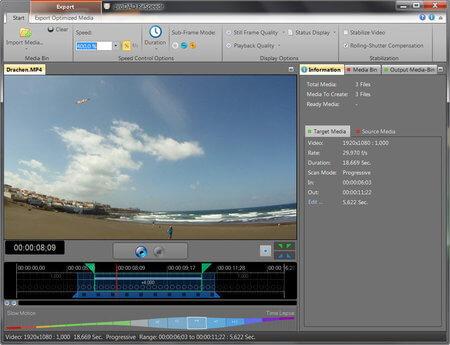
9. AviSynth
Pricing: Free
As a frameserver, AviSynth allows editing and processing without the need for temporary files. Also, this tool relies on a script system instead of a graphical user interface.Operating this can seem challenging at first but it actually is very powerful.
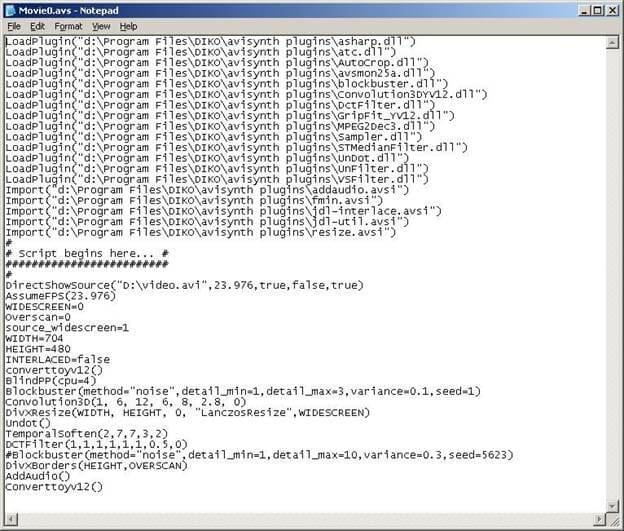
10. TimeWarp
Pricing: $9.95
For either fast or slow motion sequences, Sony offers TimeWarp. Input can be entered in numerical form or adjusted with slider controls.

11. Adobe After Effects
Pricing: $29.99/month when bundled in the creative cloud plan
As a post-processing tool with a very broad range of tools available, Adobe After Effects can successfully create slow motion videos.
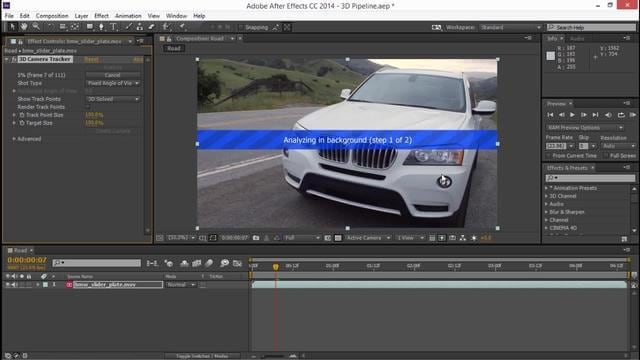
You can click here to get more information about how to edit videos in Adobe After Effects.
If you want to create a slow motion video on your iPhone or Android phone, you can try these apps: best free slo-mo video editing apps .
Slow motion video ideas - video tutorial
Check the video tutorial below to get inspired by making slow motion videos.
As we said before, with Filmora, you can change the video speed easily to make a slow motion, fast forward or freeze-frame video. Besides that, Filmora also provides some basic video editing features such as trimming, splitting, cutting, and rotating as well as advanced features like video stabilization and tilt-shift. Download Filmora to get more creative.

Ollie Mattison
Ollie Mattison is a writer and a lover of all things video.
Follow @Ollie Mattison
Ollie Mattison
Mar 27, 2024• Proven solutions
Slow motion effects can add a “close-up in time”, and introduce a feeling of surreality. If you want to slow down a video to show more details or transfer a kind of atmosphere to a video, you will need video editing software to do it. Here is a list of some of the best video editors to make a video slow down in the market.
Top 10+ Slow Motion Video Editing Software
1. Wondershare Filmora
Pricing: Free trial
Not just for slowing down or speeding up videos, the Filmora can also be used for a wide array of functions, such like slippting, cropping or reversing videos, and other advanced features like green screen, PIP, and face-off. The recent revamping of the user interface supports the easier use of more tools.
Filmora offers two ways to make a slow-motion effect in a video. The quickest way of applying the slow-motion effect to video is by selecting the target clip in the timeline, clicking the Speed icon in the toolbar, and choosing the target slow speed presets from 0.5X, 0.25X, 0.1X, 0.05X and 0.01X. The smaller the preset is, the slower the video will be.

Of course, you can also right-click the video in the timeline, select the Speed and Duration option from the menu and then change the speed by dragging the speed slider or the duration period in the Custom Speed window.

Check the video below to see how to control the video speed and make a fast forward, slow motion or freeze frame video.
For detailed information about how to make a slow-motion video, you can check Tutorial: how to make a slow/fast motion video.
If you’re looking for something more than simple speed change, read this: Ways to Make Smooth Slow-motion and Fast-motion effect.
3. Twixtor
Pricing: Ranges from $82.49 for the upgrades to $595.00 for the full version
Continuously raising the bar for slow motion editing software, Twixtor is probably the most popular and highly praised video editing application that focuses on slow and fast motions in the market. Despite the commendations the software keeps getting, its pricing may be a little too expensive. The full version of Twixtor Pro falls at $595.00.

4. Slomovideo
Pricing: Free
Although its bare and unappealing graphical user interface might turn off some people, Slomovideo does what it was created to do, which is to slow motion in videos down, quite well. To add to that, Slomovideo is an open source program, which means that it is free. A downside, however, is that it seems slower than other software and applications. However, if you are opposed to shelling out hundreds of dollars in order to produce a crisp and smooth slow motion video with expensive software, then this freeware is for you.

5. MotionPerfect
Pricing: $49.95
This cross-platform utility allows the speed and frame rate to be set and the duration of the files to be changed. Motion compensated interpolation and morphing algorithms are used instead of repeating or blending contiguous frames.

6. Apple Motion
Pricing: Bundled with Apple Final Cut Studio
The feature Optical Flow within Apple Motion was once obscure but now many users attest to its quality. Being bundled with the Apple Final Cut Studio already, previous FCS users can use Apple Motion for free.

7. Boris Continuum Time Unit
Pricing: $199.00
Using the retiming effects of Optical Flow along with the automatic keyframe generation of the Beat Reactor, Boris Continuum Time Unit can produce high-quality slow and fast motion videos.

8. ReSpeedr
Pricing: $99
Similar to Slomovideo, Respeedr is also an open source video editing tool. It is a stand-alone application that makes use of a frame-based motion-flow analysis, which means that it uses dynamic frame-blending.It offers an array of time lapse and slow motion tools that are needed to make the transition smooth but the quality of the video crisp. Moreover, its graphical user interface is very easy to understand.

9. AviSynth
Pricing: Free
As a frameserver, AviSynth allows editing and processing without the need for temporary files. Also, this tool relies on a script system instead of a graphical user interface.Operating this can seem challenging at first but it actually is very powerful.

10. TimeWarp
Pricing: $9.95
For either fast or slow motion sequences, Sony offers TimeWarp. Input can be entered in numerical form or adjusted with slider controls.

11. Adobe After Effects
Pricing: $29.99/month when bundled in the creative cloud plan
As a post-processing tool with a very broad range of tools available, Adobe After Effects can successfully create slow motion videos.

You can click here to get more information about how to edit videos in Adobe After Effects.
If you want to create a slow motion video on your iPhone or Android phone, you can try these apps: best free slo-mo video editing apps .
Slow motion video ideas - video tutorial
Check the video tutorial below to get inspired by making slow motion videos.
As we said before, with Filmora, you can change the video speed easily to make a slow motion, fast forward or freeze-frame video. Besides that, Filmora also provides some basic video editing features such as trimming, splitting, cutting, and rotating as well as advanced features like video stabilization and tilt-shift. Download Filmora to get more creative.

Ollie Mattison
Ollie Mattison is a writer and a lover of all things video.
Follow @Ollie Mattison
Ollie Mattison
Mar 27, 2024• Proven solutions
Slow motion effects can add a “close-up in time”, and introduce a feeling of surreality. If you want to slow down a video to show more details or transfer a kind of atmosphere to a video, you will need video editing software to do it. Here is a list of some of the best video editors to make a video slow down in the market.
Top 10+ Slow Motion Video Editing Software
1. Wondershare Filmora
Pricing: Free trial
Not just for slowing down or speeding up videos, the Filmora can also be used for a wide array of functions, such like slippting, cropping or reversing videos, and other advanced features like green screen, PIP, and face-off. The recent revamping of the user interface supports the easier use of more tools.
Filmora offers two ways to make a slow-motion effect in a video. The quickest way of applying the slow-motion effect to video is by selecting the target clip in the timeline, clicking the Speed icon in the toolbar, and choosing the target slow speed presets from 0.5X, 0.25X, 0.1X, 0.05X and 0.01X. The smaller the preset is, the slower the video will be.

Of course, you can also right-click the video in the timeline, select the Speed and Duration option from the menu and then change the speed by dragging the speed slider or the duration period in the Custom Speed window.

Check the video below to see how to control the video speed and make a fast forward, slow motion or freeze frame video.
For detailed information about how to make a slow-motion video, you can check Tutorial: how to make a slow/fast motion video.
If you’re looking for something more than simple speed change, read this: Ways to Make Smooth Slow-motion and Fast-motion effect.
3. Twixtor
Pricing: Ranges from $82.49 for the upgrades to $595.00 for the full version
Continuously raising the bar for slow motion editing software, Twixtor is probably the most popular and highly praised video editing application that focuses on slow and fast motions in the market. Despite the commendations the software keeps getting, its pricing may be a little too expensive. The full version of Twixtor Pro falls at $595.00.

4. Slomovideo
Pricing: Free
Although its bare and unappealing graphical user interface might turn off some people, Slomovideo does what it was created to do, which is to slow motion in videos down, quite well. To add to that, Slomovideo is an open source program, which means that it is free. A downside, however, is that it seems slower than other software and applications. However, if you are opposed to shelling out hundreds of dollars in order to produce a crisp and smooth slow motion video with expensive software, then this freeware is for you.

5. MotionPerfect
Pricing: $49.95
This cross-platform utility allows the speed and frame rate to be set and the duration of the files to be changed. Motion compensated interpolation and morphing algorithms are used instead of repeating or blending contiguous frames.

6. Apple Motion
Pricing: Bundled with Apple Final Cut Studio
The feature Optical Flow within Apple Motion was once obscure but now many users attest to its quality. Being bundled with the Apple Final Cut Studio already, previous FCS users can use Apple Motion for free.

7. Boris Continuum Time Unit
Pricing: $199.00
Using the retiming effects of Optical Flow along with the automatic keyframe generation of the Beat Reactor, Boris Continuum Time Unit can produce high-quality slow and fast motion videos.

8. ReSpeedr
Pricing: $99
Similar to Slomovideo, Respeedr is also an open source video editing tool. It is a stand-alone application that makes use of a frame-based motion-flow analysis, which means that it uses dynamic frame-blending.It offers an array of time lapse and slow motion tools that are needed to make the transition smooth but the quality of the video crisp. Moreover, its graphical user interface is very easy to understand.

9. AviSynth
Pricing: Free
As a frameserver, AviSynth allows editing and processing without the need for temporary files. Also, this tool relies on a script system instead of a graphical user interface.Operating this can seem challenging at first but it actually is very powerful.

10. TimeWarp
Pricing: $9.95
For either fast or slow motion sequences, Sony offers TimeWarp. Input can be entered in numerical form or adjusted with slider controls.

11. Adobe After Effects
Pricing: $29.99/month when bundled in the creative cloud plan
As a post-processing tool with a very broad range of tools available, Adobe After Effects can successfully create slow motion videos.

You can click here to get more information about how to edit videos in Adobe After Effects.
If you want to create a slow motion video on your iPhone or Android phone, you can try these apps: best free slo-mo video editing apps .
Slow motion video ideas - video tutorial
Check the video tutorial below to get inspired by making slow motion videos.
As we said before, with Filmora, you can change the video speed easily to make a slow motion, fast forward or freeze-frame video. Besides that, Filmora also provides some basic video editing features such as trimming, splitting, cutting, and rotating as well as advanced features like video stabilization and tilt-shift. Download Filmora to get more creative.

Ollie Mattison
Ollie Mattison is a writer and a lover of all things video.
Follow @Ollie Mattison
Ollie Mattison
Mar 27, 2024• Proven solutions
Slow motion effects can add a “close-up in time”, and introduce a feeling of surreality. If you want to slow down a video to show more details or transfer a kind of atmosphere to a video, you will need video editing software to do it. Here is a list of some of the best video editors to make a video slow down in the market.
Top 10+ Slow Motion Video Editing Software
1. Wondershare Filmora
Pricing: Free trial
Not just for slowing down or speeding up videos, the Filmora can also be used for a wide array of functions, such like slippting, cropping or reversing videos, and other advanced features like green screen, PIP, and face-off. The recent revamping of the user interface supports the easier use of more tools.
Filmora offers two ways to make a slow-motion effect in a video. The quickest way of applying the slow-motion effect to video is by selecting the target clip in the timeline, clicking the Speed icon in the toolbar, and choosing the target slow speed presets from 0.5X, 0.25X, 0.1X, 0.05X and 0.01X. The smaller the preset is, the slower the video will be.

Of course, you can also right-click the video in the timeline, select the Speed and Duration option from the menu and then change the speed by dragging the speed slider or the duration period in the Custom Speed window.

Check the video below to see how to control the video speed and make a fast forward, slow motion or freeze frame video.
For detailed information about how to make a slow-motion video, you can check Tutorial: how to make a slow/fast motion video.
If you’re looking for something more than simple speed change, read this: Ways to Make Smooth Slow-motion and Fast-motion effect.
3. Twixtor
Pricing: Ranges from $82.49 for the upgrades to $595.00 for the full version
Continuously raising the bar for slow motion editing software, Twixtor is probably the most popular and highly praised video editing application that focuses on slow and fast motions in the market. Despite the commendations the software keeps getting, its pricing may be a little too expensive. The full version of Twixtor Pro falls at $595.00.

4. Slomovideo
Pricing: Free
Although its bare and unappealing graphical user interface might turn off some people, Slomovideo does what it was created to do, which is to slow motion in videos down, quite well. To add to that, Slomovideo is an open source program, which means that it is free. A downside, however, is that it seems slower than other software and applications. However, if you are opposed to shelling out hundreds of dollars in order to produce a crisp and smooth slow motion video with expensive software, then this freeware is for you.

5. MotionPerfect
Pricing: $49.95
This cross-platform utility allows the speed and frame rate to be set and the duration of the files to be changed. Motion compensated interpolation and morphing algorithms are used instead of repeating or blending contiguous frames.

6. Apple Motion
Pricing: Bundled with Apple Final Cut Studio
The feature Optical Flow within Apple Motion was once obscure but now many users attest to its quality. Being bundled with the Apple Final Cut Studio already, previous FCS users can use Apple Motion for free.

7. Boris Continuum Time Unit
Pricing: $199.00
Using the retiming effects of Optical Flow along with the automatic keyframe generation of the Beat Reactor, Boris Continuum Time Unit can produce high-quality slow and fast motion videos.

8. ReSpeedr
Pricing: $99
Similar to Slomovideo, Respeedr is also an open source video editing tool. It is a stand-alone application that makes use of a frame-based motion-flow analysis, which means that it uses dynamic frame-blending.It offers an array of time lapse and slow motion tools that are needed to make the transition smooth but the quality of the video crisp. Moreover, its graphical user interface is very easy to understand.

9. AviSynth
Pricing: Free
As a frameserver, AviSynth allows editing and processing without the need for temporary files. Also, this tool relies on a script system instead of a graphical user interface.Operating this can seem challenging at first but it actually is very powerful.

10. TimeWarp
Pricing: $9.95
For either fast or slow motion sequences, Sony offers TimeWarp. Input can be entered in numerical form or adjusted with slider controls.

11. Adobe After Effects
Pricing: $29.99/month when bundled in the creative cloud plan
As a post-processing tool with a very broad range of tools available, Adobe After Effects can successfully create slow motion videos.

You can click here to get more information about how to edit videos in Adobe After Effects.
If you want to create a slow motion video on your iPhone or Android phone, you can try these apps: best free slo-mo video editing apps .
Slow motion video ideas - video tutorial
Check the video tutorial below to get inspired by making slow motion videos.
As we said before, with Filmora, you can change the video speed easily to make a slow motion, fast forward or freeze-frame video. Besides that, Filmora also provides some basic video editing features such as trimming, splitting, cutting, and rotating as well as advanced features like video stabilization and tilt-shift. Download Filmora to get more creative.

Ollie Mattison
Ollie Mattison is a writer and a lover of all things video.
Follow @Ollie Mattison
Also read:
- Updated In 2024, Cast It! How to Stream Local Videos From Your Device to Chromecast (2023 Update)
- Updated In 2024, Level Up Your Gaming Intros Top 10 Tools for PC and Mac Gamers
- New Download and Play The Best Websites for PC Games
- New 2024 Approved Takeaways From the Best OGG Converter
- New In 2024, Mastering Video Editing with Windows Movie Maker A Step-by-Step Guide
- New In 2024, Break Free From Windows 10 Photos Discover the Best Image Editing Tools
- Updated In 2024, Convert 4K Videos with Ease Top Picks
- 2024 Approved Loop It Like You Mean It Top 10 Free Online Video Looping Tools
- New 2024 Approved How to Resize and Crop Images in FCPX 2023 Update
- New 2024 Approved Top Cartoon Animation Creators for Mobile Devices
- Updated 2024 Approved Supercharge Adobe Premiere Pro The Best Free and Paid Plugins
- Updated Smartphone Storytelling Mastering Vertical Video Creation for 2024
- New 2024 Approved Best Cheap yet Powerful Video Editing Software
- New 2024 Approved The Easy Filmmaker Turn Your Ideas Into a Movie
- In 2024, Get Noticed How to Create the Perfect Facebook Video Cover Size
- New 2024 Approved No-Cost Video Merging The Top Online Solutions
- New 2024 Approved Resizing and Reformatting How to Change Aspect Ratio in FCP
- Uncovering the Best OGG Converter Features and Benefits
- In 2024, Transform Your Photos Into Stunning Videos with These Top Makers
- Updated Rise and Shine Wake Up to Savings with Our Filmora Easter Sale
- New Final Cut Pro X Troubleshooting Handbook Fixing Common Issues
- Updated Rotate, Reflect, and Flip Mastering Clip Orientation in Final Cut Pro
- New Whats My Aspect Ratio? Calculator and Tutorial for 2024
- New In 2024, Sizing Up Success The Importance of Correct Facebook Video Covers
- New 2024 Approved Video Aspect Ratio Conversion Tips and Tricks
- Updated Before We Delve Into the Software Tools, Lets First Understand the Basics of Video Limits that Video Editors Can Handle, Ensuring Its Quality for 2024
- New The Art of Flawless Conversion Video to MP3 without Losing a Beat
- New Free Video Looping Software for Windows and Mac
- Wax Video Editing Essentials A Guide to Getting Started with This Free Editor for 2024
- Updated 2024 Approved Windows Movie Maker for Mac Discover the Best Alternatives
- Updated In 2024, The Best Websites for Making Lyric Videos (Free and Paid)
- 2024 Approved VN Video Editor for Mac A Comprehensive Guide and Alternative Options
- Updated 2024 Approved Take Your Editing to the Next Level Advanced Jump Cuts in Final Cut Pro X
- New 2024 Approved Movie Magic 9 Best Intro Makers for Your Video Projects
- Updated In 2024, Optimize Your Rig Premiere Pro System Requirements and Setup Guide
- 2024 Approved Convert Facebook Videos to MP3 Top 8 Online Solutions
- In 2024, Discover the Secrets to Effortless Mp3 Conversion on Windows A Essential Read
- Filmora Deals and Steals Your Go-To Resource for Coupon Codes
- New In 2024, Experience Final Cut Pro for Free 90-Day Trial Offer
- Convert YouTube Videos to MP3 with Ease Best Tools
- New Easy Video Editing for Starters Best Free and Paid Software 2024
- Updated In 2024, From Audio to Video A Guide to Successful MP3 to MP4 Conversion
- Unleash Your Creativity The Top iPad Video Editing Apps for 2024
- New In 2024, Cutting-Edge AVI Video Editors Top 16 Picks for Trimming and Cutting Cross-Platform
- In 2024, How to Bypass iCloud Lock on Apple iPhone 11 Pro
- New Add Neon Effects to Your Dance Videos with the Help of Wondershare Filmora After Reading This Article. It Will Give a More Thrilling and Exciting Appearance
- Updated In 2024, 15 Best Pics Collage Apps Top Picks
- In 2024, Easy Ways to Manage Your Nokia G310 Location Settings | Dr.fone
- Complete Fixes To Solve iPhone 15 Pro Max Randomly Asking for Apple ID Password
- Updated 2024 Approved How To Make a Polaroid Collage
- How to Transfer Photos From Honor Magic 6 Lite to Samsung Galaxy S21 Ultra | Dr.fone
- Recover your music after Itel A05s has been deleted
- In 2024, Does Airplane Mode Turn off GPS Location On Xiaomi Civi 3? | Dr.fone
- How To Change Your SIM PIN Code on Your Realme V30 Phone
- In 2024, Complete Fixes To Solve Apple iPhone 6 Randomly Asking for Apple ID Password | Dr.fone
- How to Resolve Infinix Smart 8 Screen Not Working | Dr.fone
- How Do You Unlock your Apple iPhone SE? Learn All 4 Methods
- In 2024, How To Remove or Bypass Knox Enrollment Service On Oppo Find X7 Ultra
- New 2024 Approved Motion Blur Magic A Comprehensive Guide to Final Cut Pro Techniques
- What Does Jailbreaking iPhone SE (2022) i Do? Get Answers here | Dr.fone
- Free Game Video Editing Software The Ultimate Guide
- Want to Learn How to Make a Fortnite Montage? This Guide Will Give You the Low-Down on Creating Epic Montage Fortnite Videos that You Can Share with Other Players on Social Media Platforms for 2024
- In 2024, Pokemon Go No GPS Signal? Heres Every Possible Solution On Tecno Camon 20 Pro 5G | Dr.fone
- In 2024, Top 10 AirPlay Apps in Realme C67 5G for Streaming | Dr.fone
- Title: New System Requirements for Running Premiere Pro How to Set Up Computer for 2024
- Author: Charlotte
- Created at : 2024-04-29 06:43:01
- Updated at : 2024-04-30 06:43:01
- Link: https://smart-video-creator.techidaily.com/new-system-requirements-for-running-premiere-pro-how-to-set-up-computer-for-2024/
- License: This work is licensed under CC BY-NC-SA 4.0.



